Chess Notes
Edward Winter
When contacting us by e-mail, correspondents are asked to include their name and full postal address and, when providing information, to quote exact book and magazine sources. The word ‘chess’ needs to appear in the subject-line or in the message itself.
| First column | << previous | Archives [187] | next >> | Current column |
11701. A girl prodigy
From page 234 of Chess Life, August 1967, in the ‘Women’s Chess’ column by Kathryn Slater:
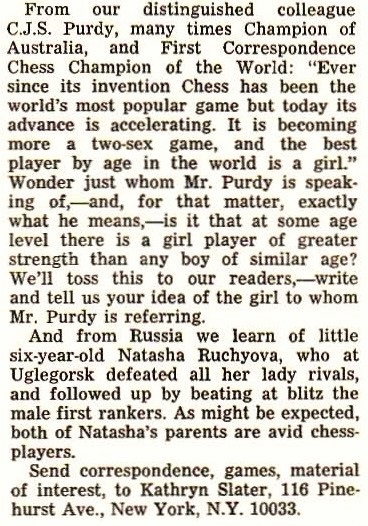
C.J.S. Purdy was referring to Jutta Hempel, whom he had discussed in Chess World earlier in the year:

The following page had the photograph of Jutta Hempel shown in C.N. 9613, and on page 52 Purdy concluded with some general remarks on prodigies and on male and female chessplayers:
‘Alas for the popular fallacy that prodigies “burn themselves out”! No chess prodigy has done this.
In my opinion the general male superiority in chess has been mainly a matter of fashion. For a long time it has been “in” for boys to play chess, and for some of them to study it from books – only those who study it become good. It has not hitherto been “in” for girls, and among them the idea of studying chess books has been regarded as eccentric. This situation is altering slightly. If it begins to change completely, chess will become again a two-sex game, as it has been at other times in history, especially in mediaeval Europe.’
11702. Chernev and Purdy
Also from page 52 of the March-April 1967 Chess World:
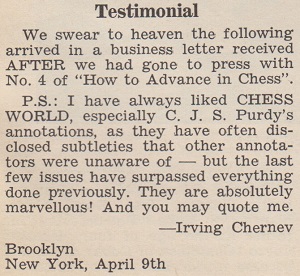
Purdy’s ‘How to Advance in Chess’ article was on pages 77 and 80 of the same issue. Most of his praise of Irving Chernev was quoted in C.N. 9713, but below is an additional passage in which Purdy related that he had recently given a chess lesson, lasting just over an hour, to a 13-year-old girl, ‘a fairly raw beginner’:
‘What would I charge for such a lesson normally? Well, at least $4, assuming I was willing to give one at all. Not many beginners care to pay so much for early lessons.
What is the answer? I saw it at once, and told the pupil, who realized I would not have time to give further lessons.
Ten years ago there was no answer. Now there is. It is Chernev’s Logical Chess Move by Move.
For this is the only book of annotated games that is comprehensible to a tyro. Every other book of annotated games leaves some moves unexplained.’
11703. Platz v Fulop
Observations by Capablanca on a game played two weeks before he died were mentioned by Joseph Platz on pages 41-42 of Chess Memoirs (Coraopolis, 1979).
Platz’s victory over J. Fulop in a Metropolitan Chess League match:
1 e4 e6 2 d4 d5 3 Nc3 Nf6 4 Bg5 Be7 5 e5 Nfd7 6 h4 c5 7 Nb5 f6 8 Bd3 a6 9 Qh5+ Kf8 10 Nd6 Bxd6 11 exd6 fxg5 12 hxg5 Qe8 (‘According to Capablanca, who was a spectator and analyzed the game with me later (just one week before his death), this is best as White was threatening Rh3.’) 13 Bg6 hxg6 14 Qxh8+ Kf7 15 Qh7 (‘Capablanca said that 15 Qxe8+ Kxe8 16 Rh8+ Nf8 17 dxc5 was necessary because Black would now have a satisfactory defense with ...Nf8.’) 15...cxd4 16 O-O-O Nc6 17 Rh3 Nde5 18 Rh4 Ne7 19 dxe7 Qxe7 20 Qh8 Resigns.
The bare score of the game, played in a Manhattan Chess Club v Bronx-Empire City match, was published on page 36 of the March-April 1942 American Chess Bulletin and on page 294 of The Golden Treasury of Chess by Francis J. Wellmuth (New York, 1943). The venue and date (Manhattan Chess Club, 21 February 1942) were announced by Hermann Helms on page 14 of the Brooklyn Eagle, 5 February 1942, and the results appeared on page 15 of the 26 February 1942 edition.
11704. Emanuel Lasker and the 1924 and 1927 New York tournaments
Emanuel Lasker’s absence from New York, 1927 was due to a bitter dispute with the organizers of New York, 1924, and he issued a lengthy statement on the affair at the end of 1926. Much confusion and additional controversy arose because the text was published – in German, Dutch, Spanish and English – with many variants and discrepancies. Richard Forster (Winterthur, Switzerland) has sifted through all available versions of the statement in a special article presented here: Lasker Speaks Out (1926).
11705. Purdy’s year of birth (C.N. 4924)
When the mess over the year of birth of C.J.S. Purdy (1906 or 1907?) was discussed in C.N. 4924, these statements from his own output were listed:
- Page 146 of the 1 July 1949 Chess World: ‘b. Port Said, 1907’;
- Page 282 of the December 1951 Chess World (article about Purdy by Gunars Berzzarins): ‘Purdy was born in 1907 in Port Said’;
- Page 161 of the August 1960 Chess World: ‘Born Port Said, Egypt, 1907’;
- Second edition of Purdy’s book Guide to Good Chess (Sydney, 1951), in a ‘thumbnail biography from Who’s Who in Australia’: ‘Born March 27, 1907, Port Said, Egypt’.
The list can be expanded:
- Page 52 of Chess World, 1 March 1948: ‘Purdy was born in 1907’;
- First edition of Guide to Good Chess (Sydney, 1950), in a ‘thumbnail biography from Who’s Who in Australia’: ‘Born March 27, 1907, Port Said, Egypt’;
- Third edition of Guide to Good Chess (Sydney, 1954), in the back-cover blurb, as shown in C.N. 9571:

The back cover of the fourth edition (1957) gave no year of birth but stated:
‘C.J.S. Purdy has had a distinguished Chess career dating from 1924, when at seventeen he became Chess Champion of New Zealand.’
When he won that event (Nelson, December 1924-January 1925) his youth was frequently remarked upon; his reported age, 17, is compatible with a birth-date of 27 March 1907. According to page 181 of the April 1925 BCM, Purdy was ‘only 17 years and nine months old’. The New Zealand press regularly stated that he was aged 17 and/or that he was born in 1907, and features such as the one below (from page 7 of the Manawatu Times, 8 January 1925) were commonplace:

1 d4 d5 2 Nf3 Nf6 3 c4 e6 4 Nc3 c5 5 cxd5 exd5 6 g3 Nc6 7 Bg2 cxd4 8 Nxd4 Bc5 9 Nxc6 bxc6 10 O-O O-O 11 Bg5 Ba6 12 Na4 Be7 13 Re1 Re8 14 Qd4 Ne4 15 Bxe7 Rxe7 16 e3 Nd6 17 Qc3 Rc8 18 Bh3 Rcc7 19 Qa5 Bc8 20 Bf1 Ne4 21 Rac1 Qd6 22 Nc5 Ng5 23 Bg2 Nh3+ 24 Bxh3 Bxh3 25 Qc3 h6 26 Red1 Bg4 27 Rd4 Qg6 28 Rf4 Bh3 29 Qd4 Bc8 30 f3 f5 31 e4 Qe8 32 exf5 g5 33 fxg6 Re1+ 34 Rxe1 Qxe1+ 35 Kg2 Re7 36 Rf8+ Kxf8 37 Qh8 mate.
Other Purdy games from the championship published in New Zealand newspapers were his encounters with E.H. Severne and B.W. Stenhouse, both with Purdy’s notes. An unnumbered page of Australian Chess 1915 to 1930 by Anthony Wright (Melbourne, 1997) gave the score of Purdy v F.K. Kelling (game 178), without a source.
With the barrage of evidence, and particularly from Purdy’s own pen, in favour of 1907 as his year of birth, it was natural for reference books to follow suit. See, for instance, the Purdy entries in the works by Horton (1959), Le Lionnais/Maget (1967 and 1974), Sunnucks (1970 and 1976), Chicco/Porreca (1971) and Golombek (1977). Purdy reviewed the Horton volume positively on page 226 of the October 1959 Chess World; whilst observing that his own entry was too long, he did not demur from its statement that he was born in 1907.
In the second impression (1980) of Golombek’s work, as well as the 1981 paperback edition, 27 March 1907 quietly became 27 March 1906. A possible explanation is this brief item by K. Whyld in his Quotes & Queries column on page 152 of the March 1980 BCM:
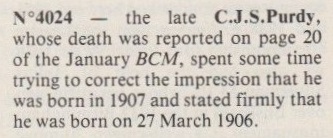
Such a bald assertion would not pass muster today. A
proper source is required, with acknowledgement that it
was Purdy himself who had been the most active
disseminator of 1907. That takes us back to the unanswered
question in C.N. 4924: when did he discover that 1907 was
wrong? If a reader has access to a run of Who’s Who in
Australia, we should like to know when that
publication switched from 1907 to 1906.
That the year 1907 is wrong can hardly be disputed given the public announcement of his birth cited in C.N. 4924. From page 1 of The Times (London) of 26 May 1906:

It remains to be clarified how the later muddle occurred.
11706. C.J.S. Purdy and Errol Flynn
From page 14 of C.J.S. Purdy, His Life, His Games and His Writings by J. Hammond and R. Jamieson (Melbourne, 1982), in the chapter ‘C.J.S. Purdy – His Life’ by Anne Purdy, his widow:
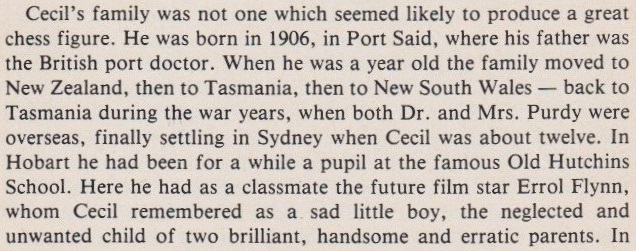
The Hutchins School was mentioned on pages 13-15 of The Young Errol by John Hammond Moore (Sydney, 1975), which asserted that Errol Flynn (born on 20 June 1909) was a pupil there:
‘Errol began his formal education at the Franklin House School on Davey Street, but by 1918 was enrolled in the junior division of the Hutchins School, Hobart’s most prestigious private, old-tie institution for miniature bluebloods.
... Errol lasted only one more term at Hutchins. (Australian schools traditionally operate on three terms of several months each from February to December.) In April of 1920 he entered Friends’ School ...’
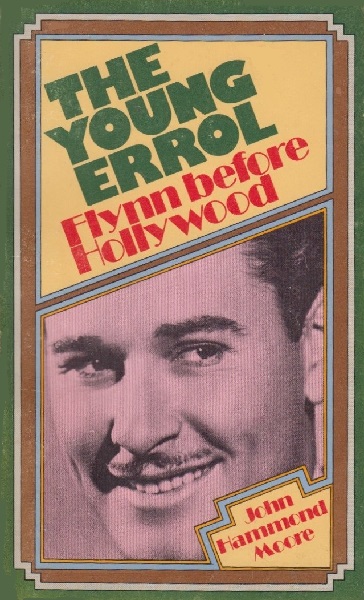
Different information is on pages 7 and 9 of Errol Flynn The Tasmanian Story by Don Norman (Hobart, 1981):
‘Errol first attended Franklin House School in July 1916, which was later incorporated in Hutchins Junior School in June 1917 ... Hutchins School is a prestigious establishment for boys begun in 1846 and modelled on the lines of the upper class English schools.
Errol went with the boys of Franklin House School to Hutchins Junior in June 1917, but remained there for only a short time before attending Albuera Street Model School ...
There is no explanation as to why Errol was taken away from Albuera Street School when he was ten years and ten months old and placed as a boarder at Friends School, a long established academy for girls and boys. He was nine months at Friends leaving on 20 December 1920.’
11707. Ghostwriter
Wanted: information about chess ghostwriting by David Daniels.
From the dust-jacket of a book which he co-authored with William Lombardy, Chess Panorama (Radnor, 1975):

11708. Harrie Grondijs (C.N.s 10439 & 10675)
Volume six of Chess Craze Bad by Harrie Grondijs, just published, is a 278-page hardback on Theodore Lichtenhein (1829-74). The back of the dust-jacket:
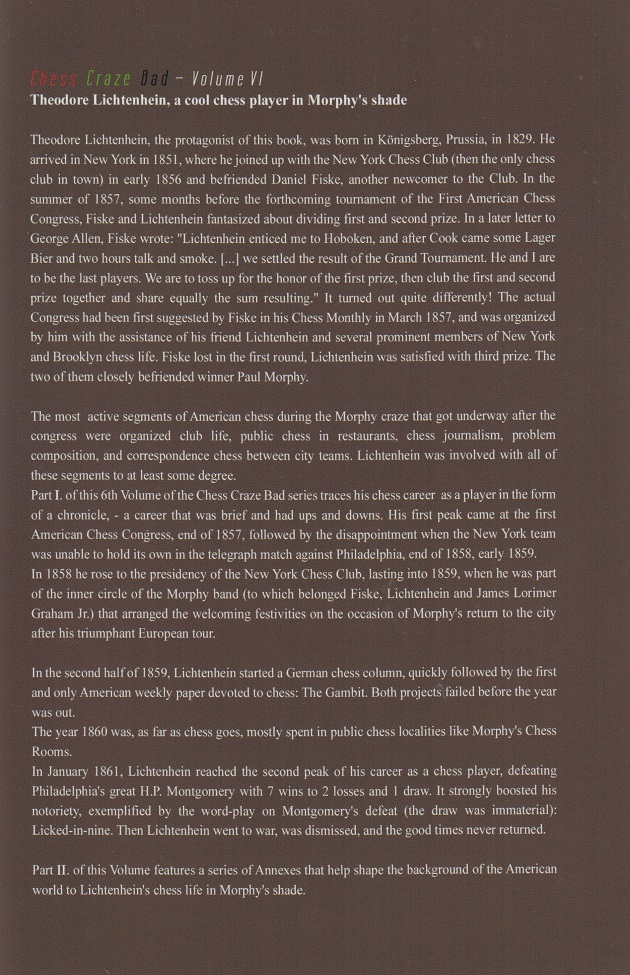
11709. Prize for the ‘best recovery’
An addition to C.N. items about unusual game prizes (listed in the Factfinder) is a draw between F.K. Kelling and E.A. Hicks which, as reported on page 13 of the Evening Star, 10 March 1923, won White the ‘best recovery’ prize in the New Zealand Championship, Christchurch, 26 December 1922:
1 e4 e6 2 d4 d5 3 Nc3 dxe4 4 Nxe4 Nd7 5 Nf3 Ngf6 6 Bd3 Nxe4 7 Bxe4 Nf6 8 Bd3 b6 9 Bb5+ Bd7 10 Bxd7+ Qxd7 11 Ne5 Qd5 12 O-O c5 13 c4 Qb7 14 Qa4+ Nd7 15 Rd1 Rd8 16 Nc6 Rc8 17 d5 a6 18 Qb3 Nf6 19 Qe3 Bd6 20 f4 O-O 21 Qd3 exd5 22 cxd5 Rfe8 23 b3 Bf8 24 Bb2 Nxd5 25 Na5 bxa5 26 Qxd5 Qb4 27 Be5 Red8 28 Qxd8 Rxd8 29 Rxd8 f6 30 Bb2 c4 31 Bd4 cxb3 32 axb3 Kf7 33 Rc1 Kg6 34 g4 Bd6 35 f5+ Kg5
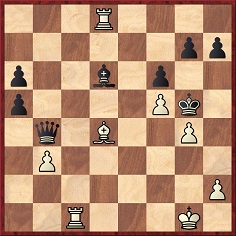
36 Be3+ Kh4 37 Kf2 Bf4 38 Rd3 Qe4 39 Ke2 Bxe3 40 Rxe3 Qg2+ 41 Kd3 a4 42 Rc4 Qb2 43 Ke4 Kxg4 44 Kd5+ Kxf5 45 Rf3+ Kg6 46 Rg3+ Drawn.

11710. Alekhine and Capablanca in St Petersburg (C.N.s 11577, 11581 & 11591)
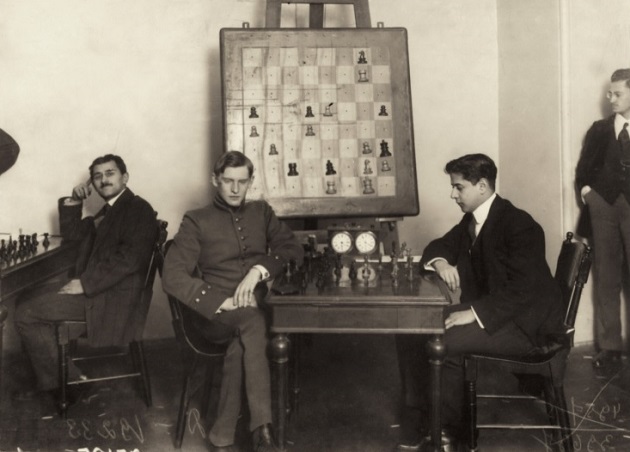
In C.N. 11577 Marcel Klemmer (Bad Segeberg, Germany) asked whether the player on the far left could be identified.
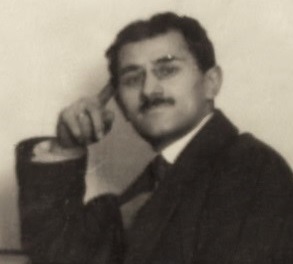
Colin Patterson (Cullercoats, England) has suggested Alexander Evenson, who won a tournament in St Petersburg in late 1913. For purposes of comparison, Yuri Kireev and Mikhail Sokolov (Moscow) have provided two group photographs:
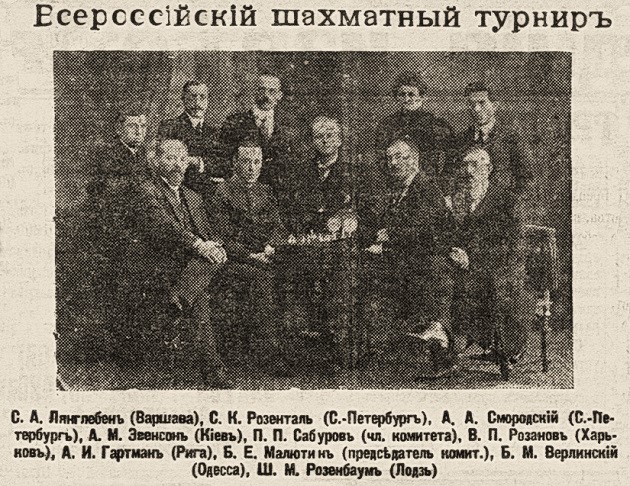
Source: Петербургская газета, 19 December 1913, page 4. Our correspondents clarify the caption as follows: Standing, from left to right: Verlinsky, Smorodsky, Rosenthal, Evenson, Rozenbaum or Gartmanis; Seated: Lyangleben, Rozanov, P.P. Saburov, Rozenbaum or Gartmanis, Malyutin.
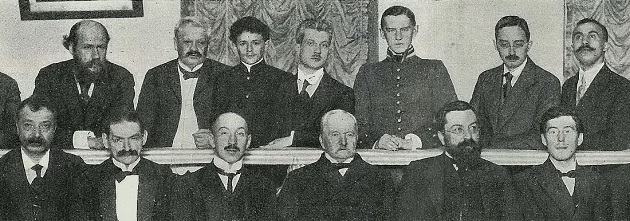
Source: Нива issue 7, 1914, page 4. Standing, from left to right: Levitzky, Alapin, Evenson, Flamberg, Alekhine, Gregory, Bogoljubow; Seated: Salwe, Sosnitsky, Malyutin, P.A. Saburov, Kutler, Levenfish.
11711. Frank J. Marshall
M.E. Goldstein, writing about Frank Marshall on page 176 of Check!, 1 April 1945:
‘The last time I saw Marshall was at the 1927 London tournament won jointly by Nimzowitsch and Tartakower. Looking like a retired Shakespearean actor, more likely to burst into a Hamlet soliloquy than into a tournament game of chess, Marshall had the satisfaction of a splendid win against Nimzowitsch, for which he was awarded the best-played game prize.’
The comparison with a Shakespearean actor is not original. Page 1 of My Fifty Years of Chess by F.J. Marshall (New York, 1942):
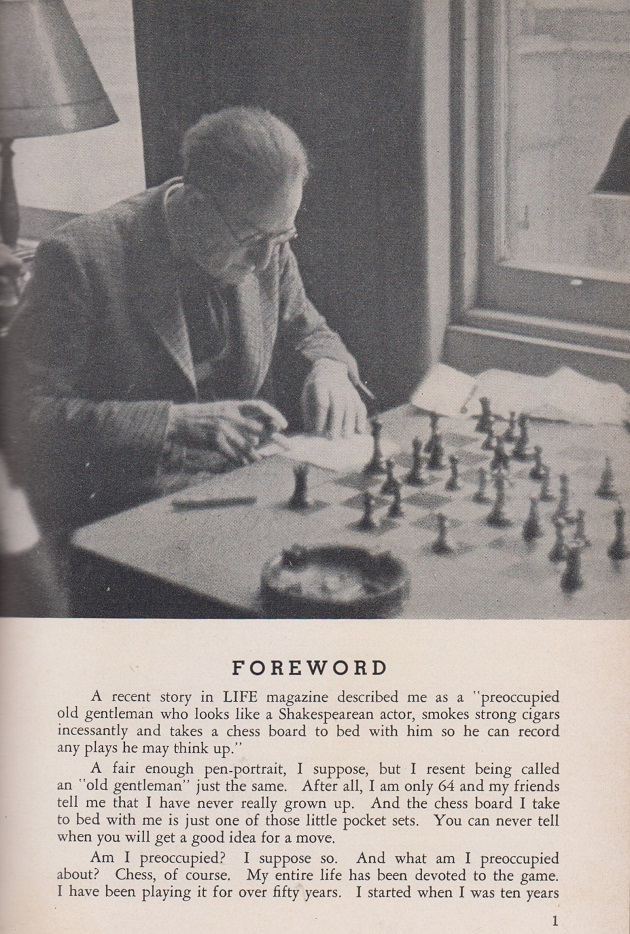
The same photograph (which brings to mind the discussion in C.N.s 5114 and 5124) was on page 180 of the October 1941 Chess Review, with a slightly different text on page 181:

The feature on Marshall was in the 29 January 1940 edition of Life, and below is the reference to Marshall’s physical appearance (page 50), a photograph of him in play against Clarence Hewlett (page 49) and a general shot of a team match (page 54):
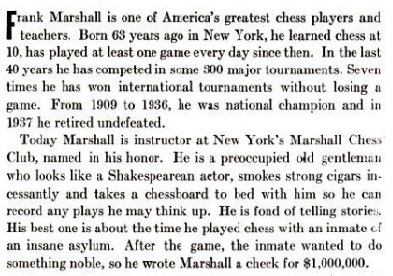
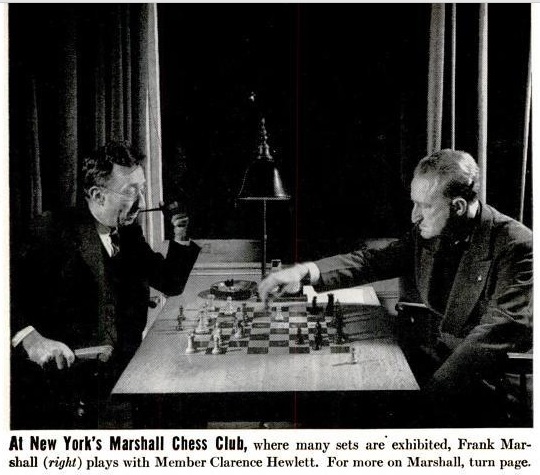
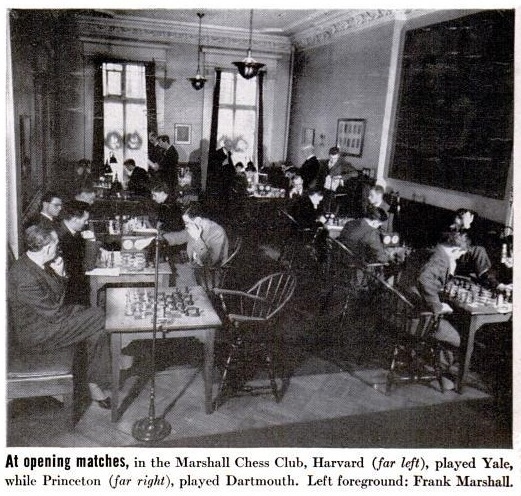
11712. Marshall photographs
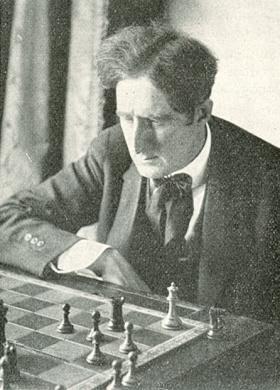
This picture from page 26 of the February 1931 American Chess Bulletin was discussed in C.N.s 5114 and 5124, the question being whether the ostensibly incorrect board position was a photographic illusion.
The same, or a very similar, chessboard is on the front cover of the December 1944 Chess Review:

11713. A Chinese proverb (C.N. 8037)
On the subject of chess and proverbs, C.N. 8037 asked on what basis the observation ‘Life is like a game of chess, changing with each move’ could be labelled a ‘Chinese proverb’.
From page 252 of A Collection of Chinese Proverbs translated and arranged by William Scarborough (Shanghai, 1875):
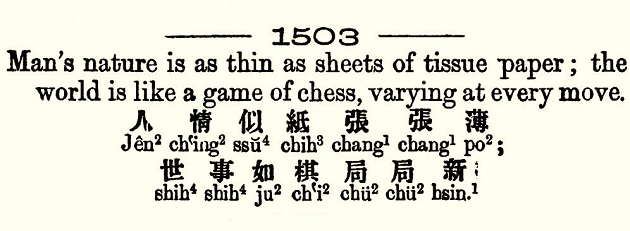
11714. FIDE diplomas
From his archives Jan Kalendovský (Brno, Czech Republic) sends three diplomas awarded to Ilja Mikan:
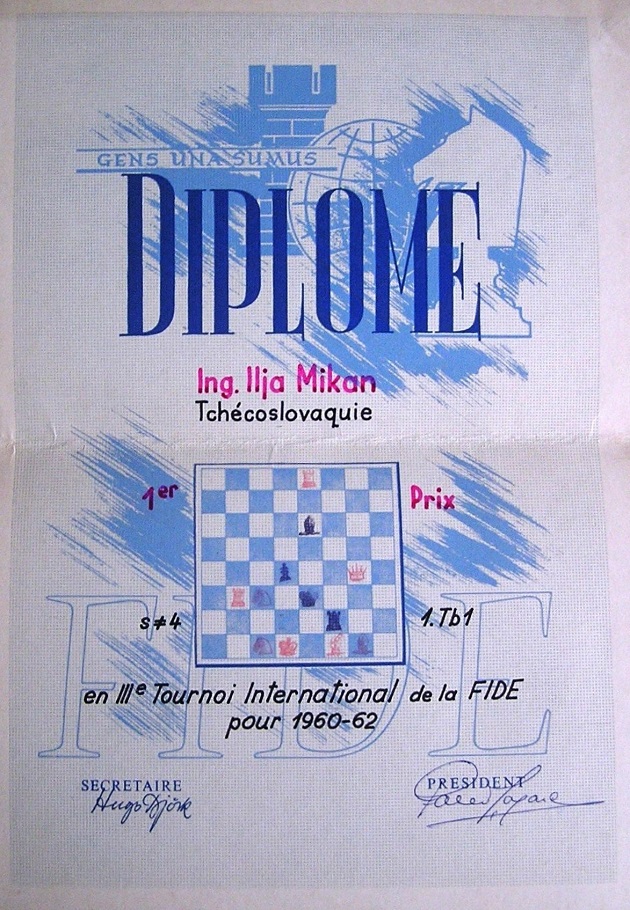
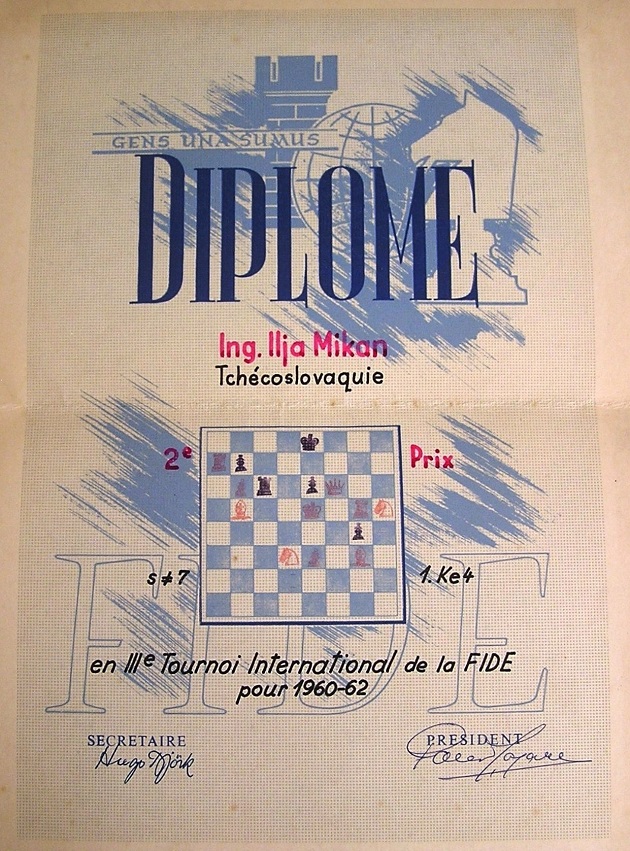
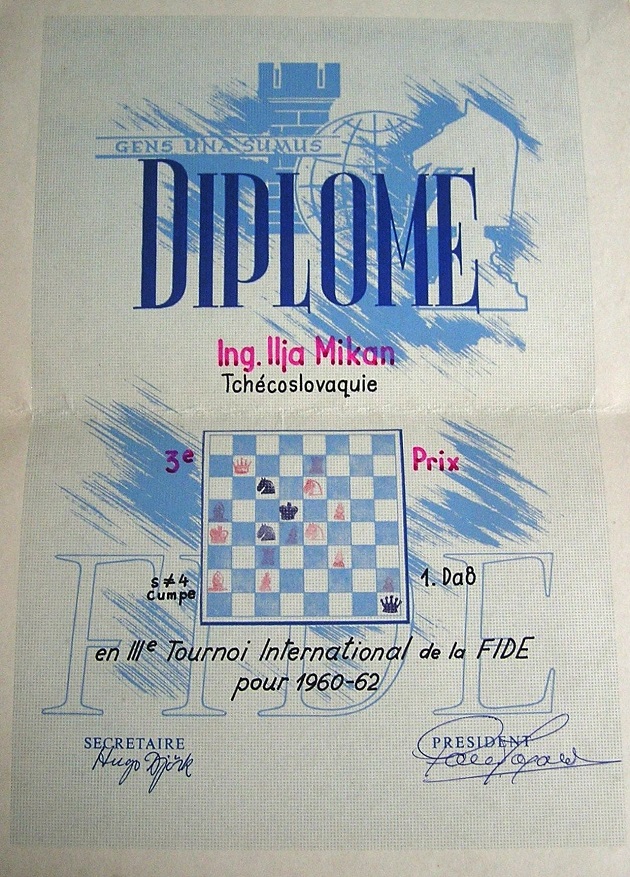
11715. Book publishing activity in the 1940s
Courtesy of Harrie Grondijs (Maastricht, the Netherlands), below is a letter dated 1 November 1945 from E.G.R. Cordingley to J. Selman:
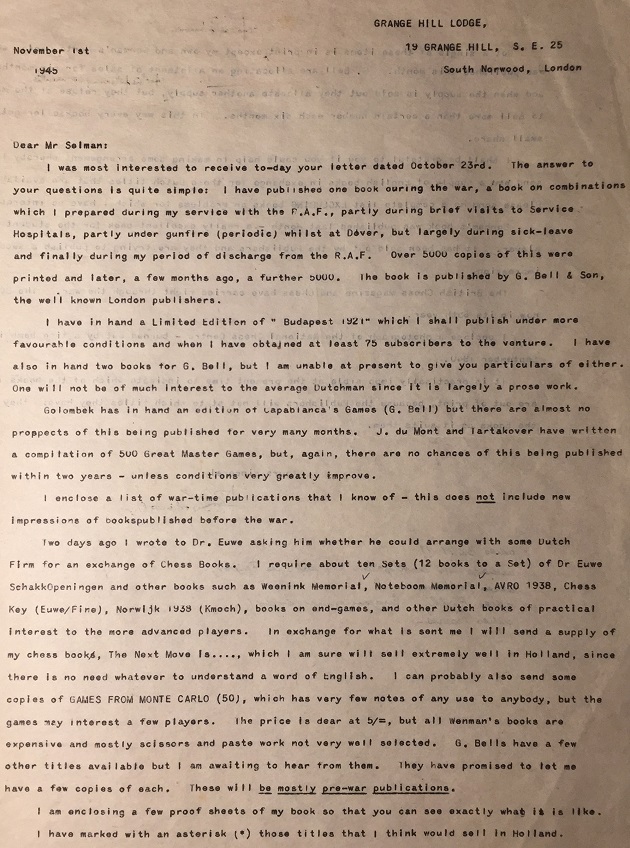

11716. Money and book/magazine sales
Although many websites have historical currency converters purportedly able to show today’s equivalent of, for instance, Morphy’s fee for his New York Ledger column, the London Rules purse, or the prize-money for the 1972 Spassky v Fischer match, the results may vary wildly according to the criteria used. Is there a consensus among economists as to the best way of using such online tools, if at all?
Readers of books by Ely Culbertson will see, regarding bridge, far more references to money and to sales of books/magazines – and much higher figures – than exist in the chess world. As a further illustration, we quote some passages from Culbertson The Man Who Made Contract Bridge by John Clay (London, 1985):
- [Bridge World: $3.50 for an annual subscription]: ‘The first printing of 20,000 copies was quickly sold out and a strategic reserve of 5,000 had to [be] used up, leaving an unmet demand for a further 3,000 copies from subscribers who sent in the application form after the publication date.’ (Page 88.)
- ‘The New Year [1931] brought with it news that the circulation of Bridge World now stood at 40,000. ... It seemed like a good moment to bring out the promised summary of the Culbertson System of Contract bridge, Contract Bridge at a Glance. This was priced at $1 and had 48 pages of text. It proved to be the biggest money spinner of all. The first two impressions totalling 40,000 copies were sold before publication – by 1937, sales had reached 713,000 copies.’ (Pages 110-111.)
- [Early 1932] ‘Back in New York he found things had got off to a flying start. The Blue Book and the recently issued Summary (Contract Bridge at a Glance) were selling at a phenomenal rate. On one day alone orders had come into Bridge World offices for over 5,000 copies of the Blue Book and 11,000 copies of the Summary.’ (Page 135.)
- ‘Chesterfield cigarettes were the other manufacturers to form a long and profitable association with Culbertson. They wanted to produce a small cigarette-pack size booklet on bridge and distribute it free with their name emblazoned all over it. Culbertson let them have a schedule of prices relating to authorship of the booklet. If he alone was to be the author, that would cost $7,500 ... Chesterfield opted for Culbertson himself and in the end over three million copies of the booklet were distributed.’ (Page 137.)
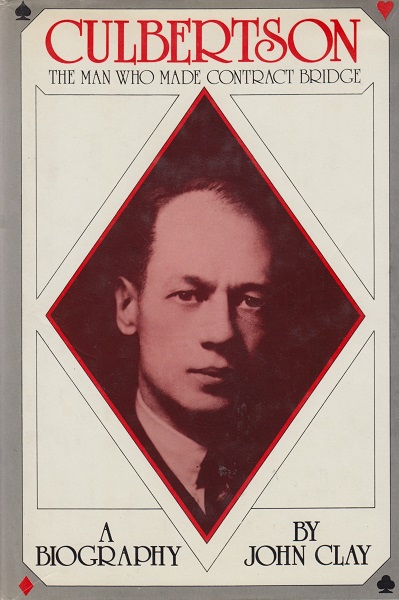
- ‘Books poured forth after the Lenz match. The Garden City Publishing Co. in New York approached him for a book for their “Star Dollar Series”, one-dollar-books that were distributed through chain stores. Culbertson remembered that a chapter had been put into type for the Blue Book but excluded at the last minute as it would make the book bigger than required. Advance royalties of $10,000 were produced and the discarded manuscript was renamed Contract Bridge for Auction Players and embellished with some hands from the Lenz match. Thus a 200-page best-selling book was put together in next to no time and Culbertson reaped an easy $10,000.’ (Page 138.)
- ‘The first steps towards Hollywood were taken in June 1932 when Deac Aylesworth of NBC got in touch with Culbertson and said that Ned Depinet of RKO was interested in making a series of pictures on bridge ... In all they made six featurettes ... he was paid $270,000 for his work.’ (Pages 139 and 141.)
- ‘Albert Morehead, his right-hand man, later calculated that for the year 1933 to 1934 the joint income of Ely and Josephine [his wife] amounted to over $350,000 per annum, made up of (the figures are approximate) $140,000 from royalties on his books (mainly the best-selling Culbertson summary), $135,000 for his movie shorts, $40,000 in other royalties, $22,000 for newspaper and magazine articles, $10,000 for lectures and $10,000 for miscellaneous endorsements.’ (Page 167.)
- ‘He had died broke – the millions accumulated in the heyday of the bridge years had long gone.’ (Page 227.)
11717. Further photographs
Another selection of photographs from Alt om Skak by Bjørn Nielsen (Odense, 1943) on, respectively, pages 118, 187 and 191:
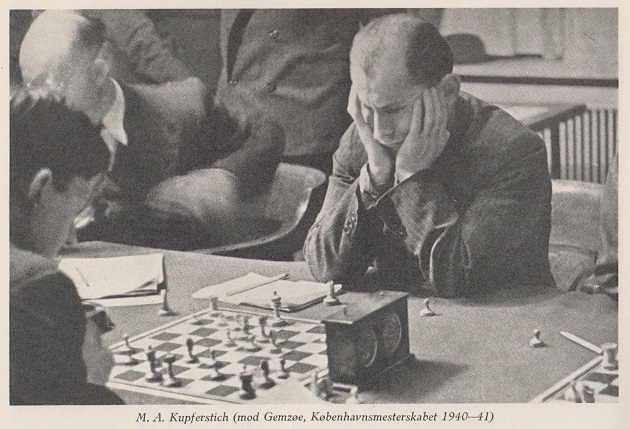
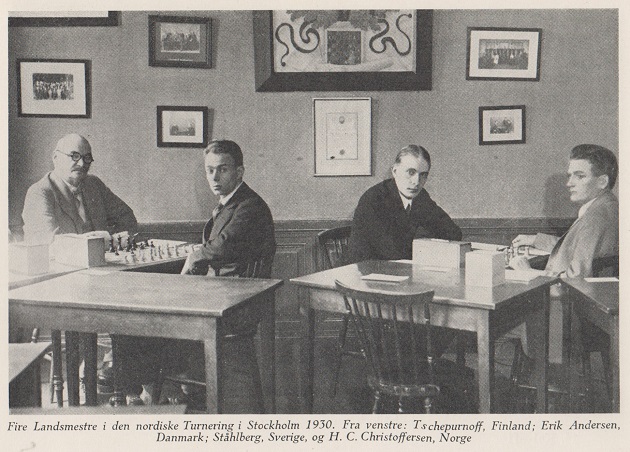
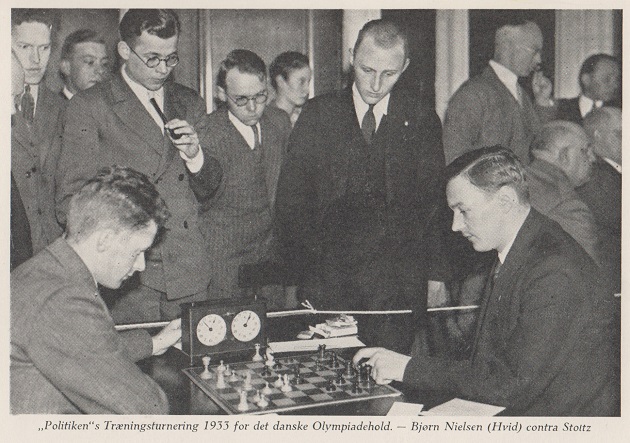
11718. H. Rose
A photograph of H. Rose is requested in view of this paragraph on page 152 of Chess Memoirs by Joseph Platz (Coraopolis, 1979), introducing a game apparently played in 1967:
‘My opponent in the next game bore a striking resemblance to Akiba Rubinstein, one of the greatest of all chess masters. It was in the New England Championship in 1954 when I played him for the first time. I beat him with comparative ease. After the game I told him: “You look like Rubinstein, but you don’t play like Rubinstein.”’
11719. J.W. Showalter’s year of birth (C.N.s 5706, 6972 & 11074)
From the unpublished 1994 edition of Jeremy Gaige’s Chess Personalia:

An additional reference is pages 44-45 of the Chess Budget, 11 November 1925:
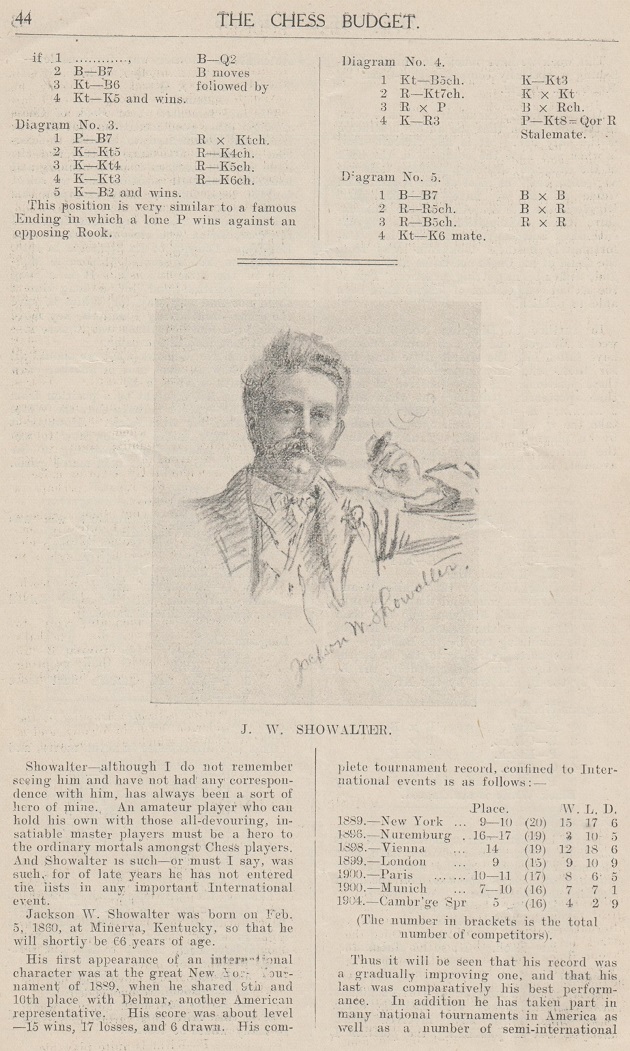

C.N. 5706 mentioned a statement that Showalter was born on 5 February 1859, and not 5 February 1860, but the appeal in C.N. 11074 for documentary evidence has yet to be answered.
11720. C.W. Kahles
Fire has been the theme of cartoons in C.N.s 8927, 8943, 10427 and 10875, and now it is shown in a Hairbreadth Harry comic strip by Charles William Kahles (1878-1931):

Brooklyn Daily Eagle, 24 January 1924, page A3

Brooklyn Daily Eagle, 25 January 1924, page A3
As discussed in C.N.s 5897 and 5921, cartoons by Kahles were published in two issues of the Chess Weekly in 1909, in relation to the Capablanca v Marshall match.
Among the references to Kahles in the American Chess Bulletin is the following, on page 119 of the May-June 1917 issue:
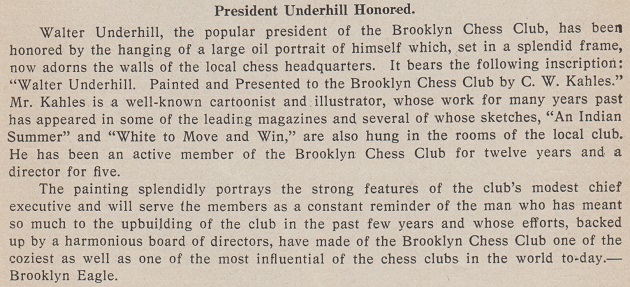
The Brooklyn Daily Eagle report had appeared on page 3 of the 3 May 1917 edition.
On the day he died, 21 January 1931, the Brooklyn Daily Eagle (pages 1 and 24) published an obituary of Kahles which included a reference to chess:
‘Mr Kahles was a life-long friend of Charles R. Macauley, editorial cartoonist of the Eagle, who only yesterday telephoned the Great Neck home and invited Kahles to sit at a table of chessplayers to play José R. Capablanca.
“When is it to be?”, Kahles asked. “Feb. 22? All right. I think I can make it then.”’
(Capablanca’s display, at the Drill Hall of the Seventh Regiment Armory, New York, was on 12 February 1931.)
An extract from Hermann Helms’ column on page 24 of the Brooklyn Daily Eagle, 22 January 1931:
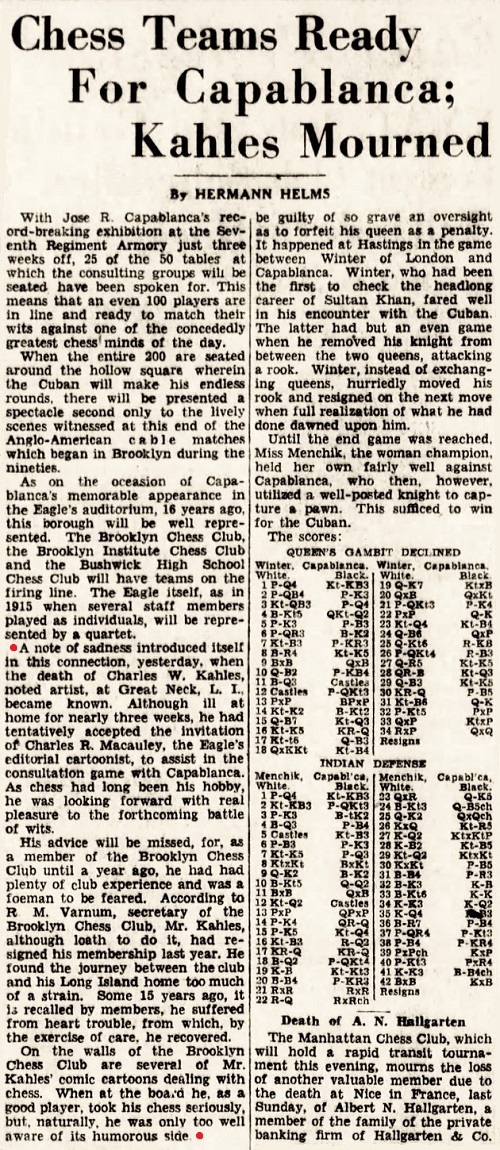
11721. Bobby Jones and chess
An article on page 2A of the Brooklyn Daily Eagle, 2 June 1924 about the golfer Bobby Jones (1902-71):

11722. Fischer in Cuba
Just received: Bobby Fischer en Cuba by Miguel A. Sánchez and Jesús Suárez (‘Printed by Amazon Italia Logistica S.r.l., Torrazza Piemonte (TO), Italy’, 2019):

Far from diligently presenting fresh, worthwhile information, the book, sullied with an inordinate number of misspelt names, is mainly padding and irrelevancies. For example, pages 28-32 and pages 293-296 are taken up with games between Capablanca and Whitaker.
11723. Max Romi/Romih (C.N.s 5162 & 5537)
C.N.s 5162 and 5537 discussed the spellings Romi and Romih, and the present item offers a snippet of extra information, taking the scenic route.
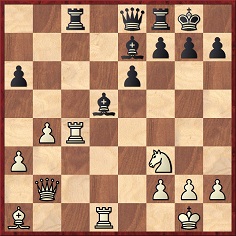
Black to move
This diagram (‘What is his best defence and why?’) was in the ‘Posers in Play’ feature by W. Ritson Morry on page 363 of the December 1970 BCM.
The solution on page 39 of the January 1971 issue:

The game was played not in 1933 but in the 1926-27 Paris championship. Its appearance on page 71 of L’Italia Scacchistica, March 1927 is shown below, courtesy of the Cleveland Public Library:
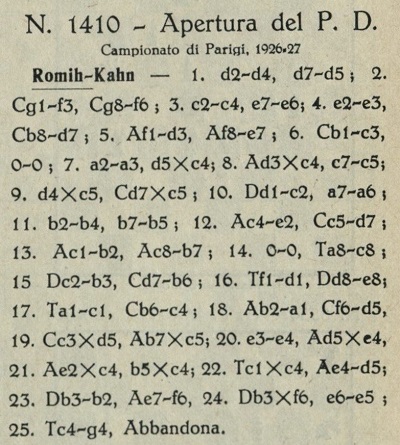
1 d4 d5 2 Nf3 Nf6 3 c4 e6 4 e3 Nbd7 5 Bd3 Be7 6 Nc3 O-O 7 a3 dxc4 8 Bxc4 c5 9 dxc5 Nxc5 10 Qc2 a6 11 b4 b5 12 Be2 Ncd7 13 Bb2 Bb7 14 O-O Rc8 15 Qb3 Nb6 16 Rfd1 Qe8 17 Rac1 Nc4 18 Ba1 Nd5 19 Nxd5 Bxd5 20 e4 Bxe4 21 Bxc4 bxc4 22 Rxc4 Bd5 23 Qb2 Bf6
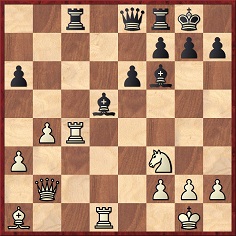
24 Qxf6 e5 25 Rg4 Resigns.
When Tartakower gave the latter phase on pages 51-52 of L’Echiquier, 23 March 1933, he did not state that the game had been played that year, but merely indicated that the occasion was ‘a’ Paris championship:

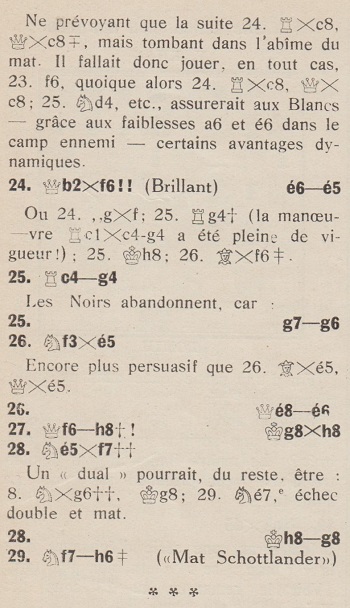
The 24 Rxc8 Qxc8 25 Nd4 line is strikingly similar to Ritson Morry’s later remark.
Among the corrections on page 155 of the 31 May 1933 edition of L’Echiquier was the statement that the Italian master wished his name to be spelt Romi, and not Romih:

11724. Schottländer’s mate
An explanation is required of Tartakower’s reference to ‘Mat Schottlander’ at the end of his annotations in the previous item, concerning this possible conclusion in the Romi v Kahn game:

White to move
27 Qh8+ Kxh8 28 Nxf7+ Kg8 29 Nh6 mate.
Page 397 of Deutsches Wochenschach, 14 November 1909:
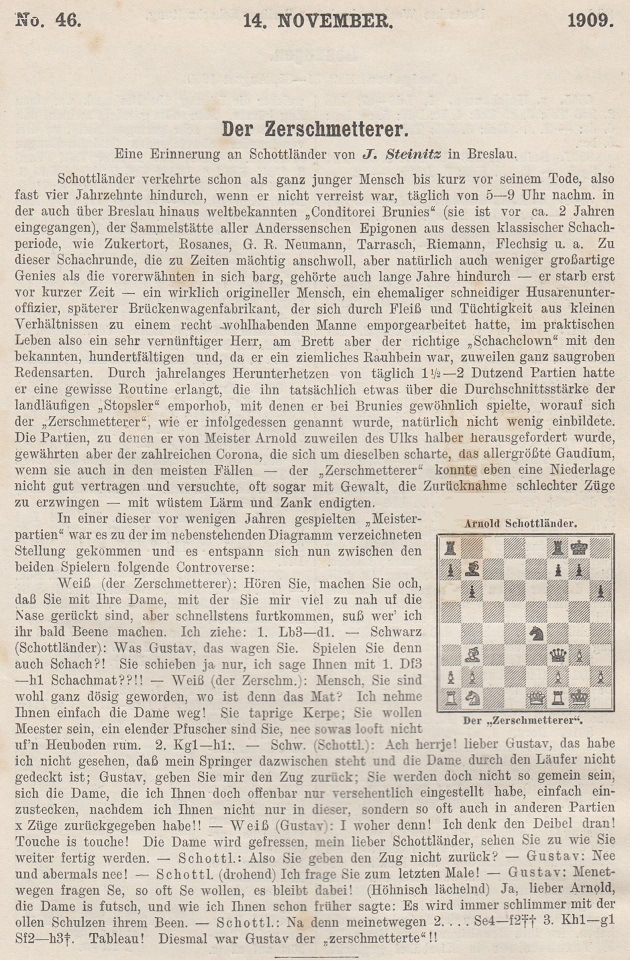
Another article was ‘Un recuerdo al maestro Schottlaender’ on page 6 of Lances humorísticos de ajedrez by Hans Cohn (Guatemala, 1938):
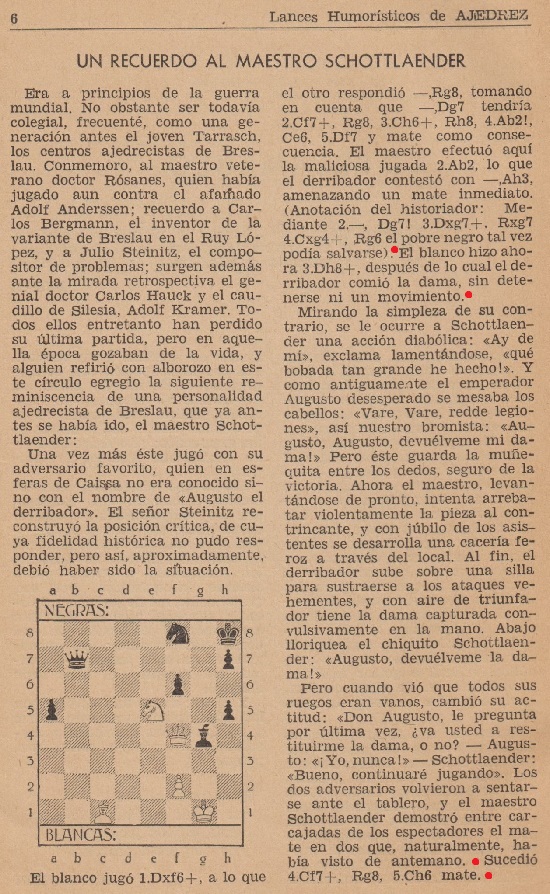

White to move
3 Qh8+ Kxh8 4 Nf7+ Kg8 5 Nh6 mate.
Cohn’s text was reprinted on pages 277-278 of the September 1938 issue of El Ajedrez Americano, and an English version of the story about Schottländer against August, the Giant-Killer was on page 278 of the December 1938 Chess Review:
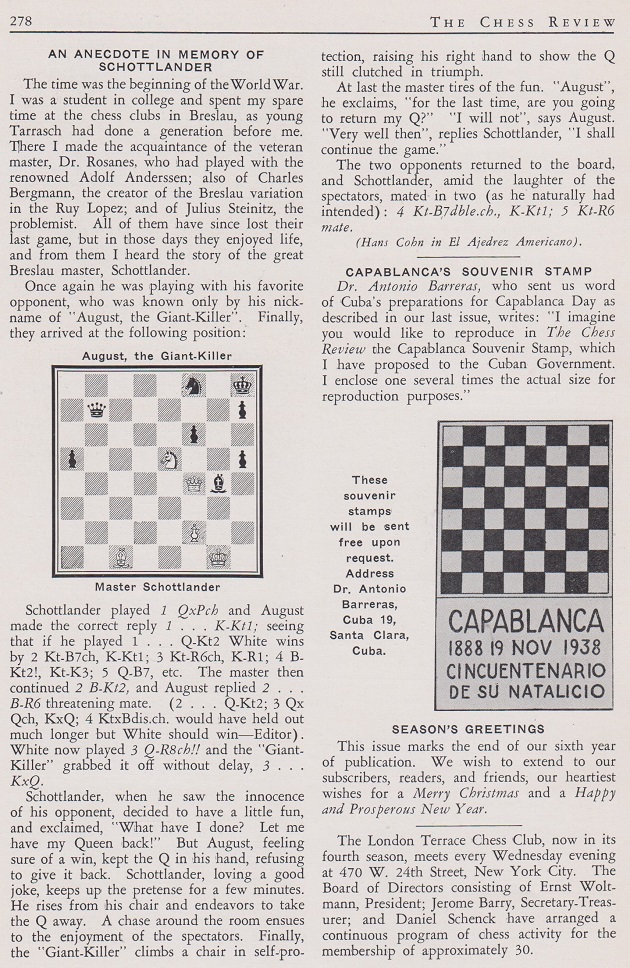
The item was reproduced on pages 164-166 of The Personality of Chess by I.A. Horowitz and P.L. Rothenberg (New York, 1963) with the author misnamed ‘Hans Cohen’.
A feature on Arnold Schöttlander which is not listed in Jeremy Gaige’s Chess Personalia was on pages 353-354 of the Chess Monthly, August 1894:
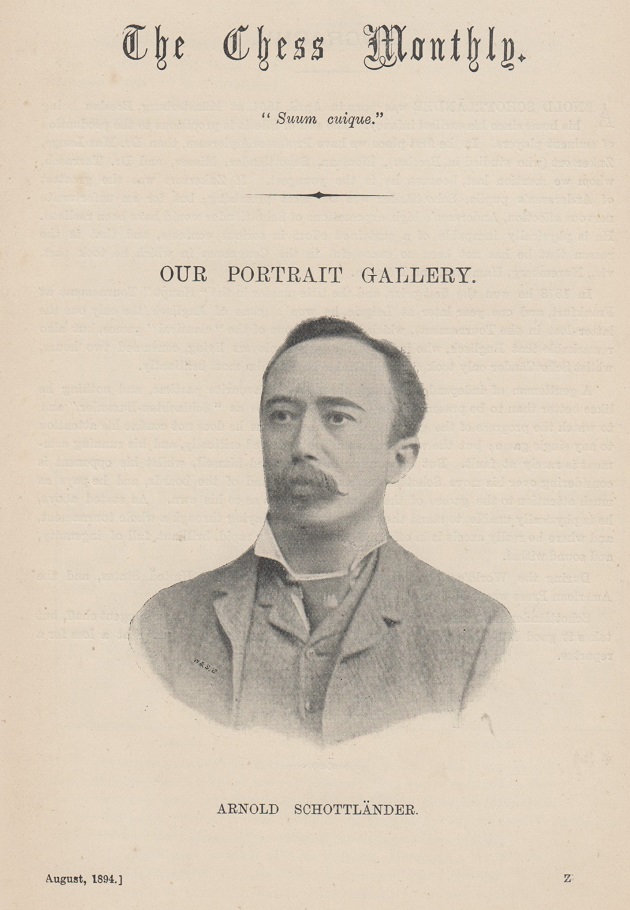

Following Schottländer’s death, Hoffer wrote in The Field of 18 September 1909:
‘Schottländer no doubt was a genius. But having been an invalid from earliest childhood, and belonging to the leisured class, he played chess as a favoured pastime, but was not physically strong enough for the strain of a tournament. Finally, he had to obey the strict injunctions of his medical advisers, and abstained from public play; but he was a regular visitor at every tournament or match, he was even present at the International Tournament in America. We saw him for the last time at Carlsbad. He was endowed with a marvellously quick appreciation of position. As soon as he arrived at the rooms where the tournament was held he passed the games in progress in review and gave his opinion about each game, and it was generally a correct appreciation. He was noted for caustic humour and ready repartee.’
11725. Hans Kmoch and his family
From Michael Lorenz (Vienna):
‘Johann Josef Kmoch was born on 25 July 1894 at Herbststraße 41, Vienna and was baptized on 5 August 1894 in the parish church of Neulerchenfeld. His parents were Wenzel Kmoch, a maker of leather fancies (Ledergalanteriearbeiter) from Prague, and his wife Karolina, née Moser. Wenzel Kmoch died on 4 May 1951. Hans Kmoch was a true “Ottakring boy”. His younger brother was Ladislaus Kmoch (1897-1971), a cartoonist of local renown who created the popular cartoon character “Tobias Seicherl”. Hans Kmoch’s nephew was the local historian Manfred Kmoch (1925-79), and his great-nephew Ladislaus Kmoch still lives in Vienna today.’
A photograph of Herbststraße 41 taken by our correspondent in July 2019:
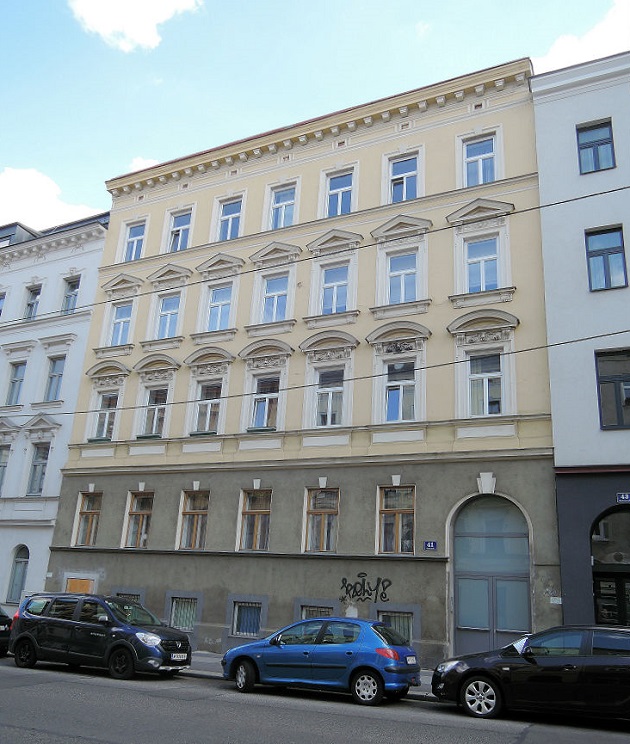
11726. Commemoration of Marcel Duchamp
Eduardo Bauzá Mercére (New York, NY, USA) reports that in January 2019 he took these photographs of the Bar Oscar, calle Adolfo Alsina 1745, Buenos Aires (which, in 2017, was named the ‘Sitio Marcel Duchamp/Francisco Canaro’):
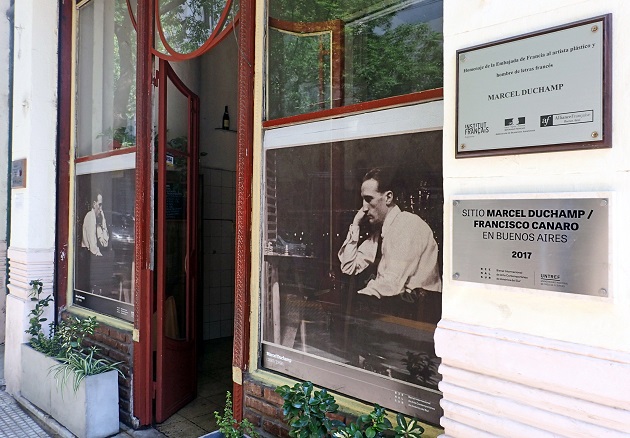

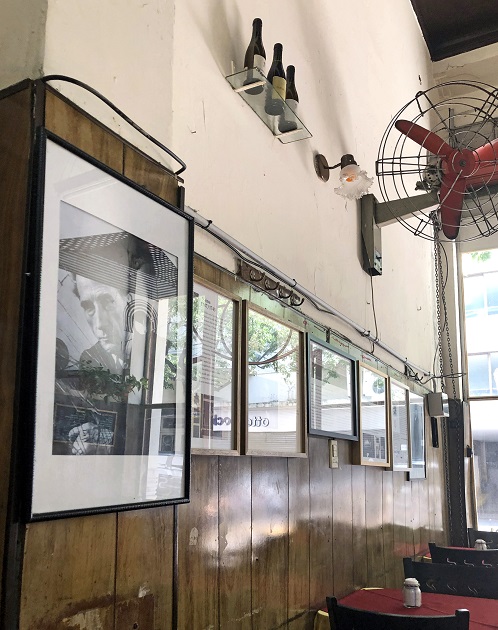
11727. C.W. Kahles (C.N. 11720)
Another Hairbreadth Harry comic strip, from page 6 of the Brooklyn Daily Eagle, 30 June 1928:

11728. Queen sacrifice
Our feature article Réti v Tartakower, Vienna, 1910 refers to a number of games with the same motif, and a further addition, with the rarity of the (lucky) winner being Black, is shown now from page 4 of the Evening Star (Dunedin), 1 July 1933:
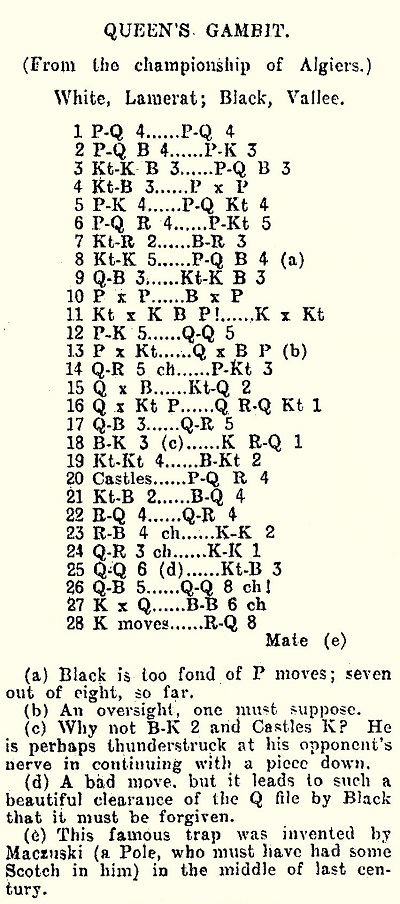
1 d4 d5 2 c4 e6 3 Nf3 c6 4 Nc3 dxc4 5 e4 b5 6 a4 b4 7 Na2 Ba6 8 Ne5 c5 9 Qf3 Nf6 10 dxc5 Bxc5 11 Nxf7 Kxf7 12 e5 Qd4 13 exf6 Qxf6 14 Qh5+ g6 15 Qxc5 Nd7 16 Qxb4 Rab8 17 Qc3 Qh4 18 Be3 Rhd8 19 Nb4 Bb7 20 O-O-O a5 21 Nc2 Bd5 22 Rd4 Qh5 23 Rf4+ Ke7 24 Qa3+ Ke8 25 Qd6 Nf6 26 Qc5
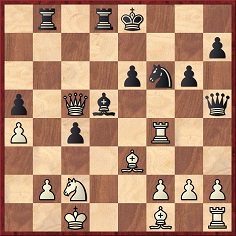
26...Qd1+ 27 Kxd1 Bf3+ 28 K moves Rd1 mate.
More information about the game and the players will be welcome.
A win by Alekhine against ‘Lamerat (champion of Algeria)’ is on page 485 of the October 1935 BCM:
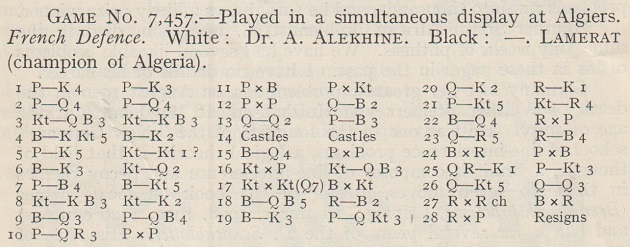
Page 513 of the Skinner/Verhoeven volume on Alekhine specified that the simultaneous exhibition took place in Algiers in December 1934.
In Jeremy Gaige’s Chess Personalia the only entry of potential relevance is for Léonce Lamérat, a problemist who had died in 1933. The Cleveland Public Library has forwarded the announcement of his death on page 258 [sic – Gaige gave ‘358’] of La Stratégie, November 1933:
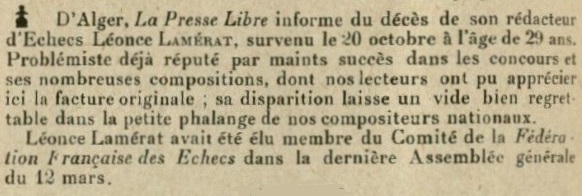
11729. Staunton’s hypermodernism
C.N. 1157 (see page 95 of Chess Explorations) quoted this passage from page 360 of the August 1926 BCM:
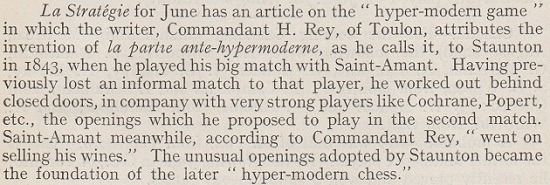
John Townsend (Wokingham, England) queries the statement that Staunton, after losing an informal match to Saint-Amant, ‘worked out behind closed doors, in company with very strong players like Cochrane, Popert, etc., the openings which he proposed to play in the second match’:
‘There is strong evidence that both Cochrane and Popert were abroad during the period in question. Preparation “behind closed doors” is claimed to have taken place between the two Staunton v Saint-Amant matches, i.e. between May and November 1843. However, page 2 of Bell’s Life in London, 11 September 1842 noted that Popert had already left England for his native Germany, “where, we believe, he intends remaining two or three years, in consequence of ill health”:

John Cochrane’s departure for India was also reported some time before the first match, in the Chess Player’s Chronicle, 1844, page 127.’
Pages 49-53 of the March 1926 edition of La Stratégie had a translation by A. Goetz of an article by Carlo Salvioli about hypermodern chess from pages 25-29 of L’Italia Scacchistica, February 1926. As shown below, the follow-up article (La Stratégie, June 1926, pages 121-122), consisted of a response submitted by Commandant H. Rey to the Marseilles newspaper Le Soleil, where the Salvioli article had also appeared in translation:

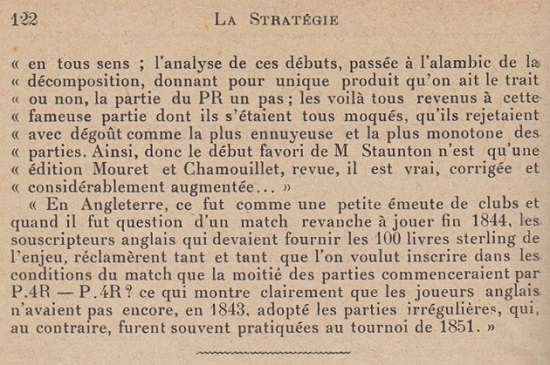
See too Hypermodern Chess.
11730. Thomas Edison’s son
From page 10 of the Sports Section of the New York Times, 29 December 1922:
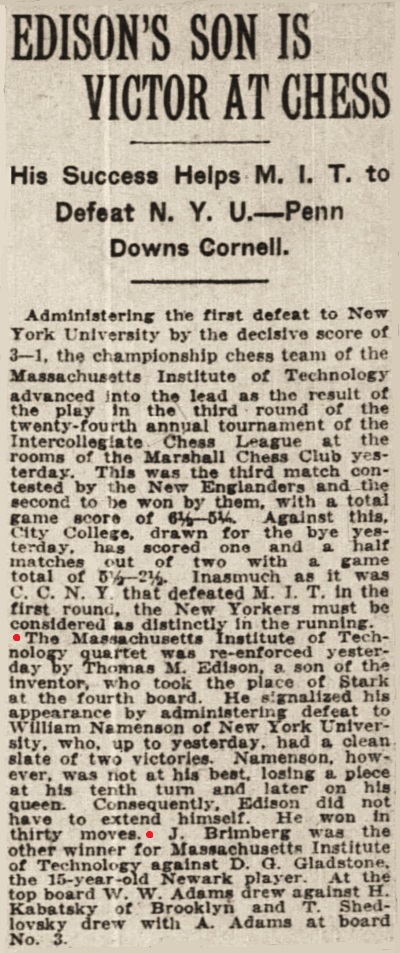
Theodore Miller Edison’s participation in the Intercollegiate Chess League match was also reported on page 11 of the American Chess Bulletin, January 1923:

The following page of the Bulletin published his loss to H.E. Everding, played on 29 [sic] December 1922:
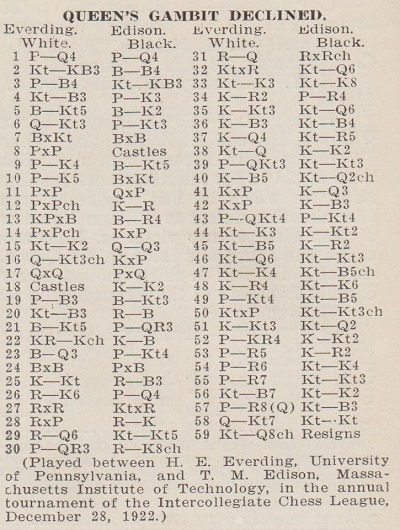
1 d4 d5 2 Nf3 Bf5 3 c4 Nf6 4 Nc3 e6 5 Bg5 Be7 6 Qb3 b6 7 Bxf6 Bxf6 8 cxd5 O-O 9 e4 Bg4 10 e5 Bxf3 11 dxe6 Qxd4 12 exf7+ Kh8 13 exf6 Bh5 14 fxg7+
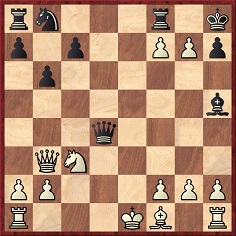
14...Kxg7 15 Ne2 Qd6 16 Qg3+ Kxf7 17 Qxd6 cxd6 18 O-O-O Ke7 19 f3 Bg6 20 Nc3 Rc8 21 Bb5 a6 22 Rhe1+ Kf8 23 Bd3 b5 24 Bxg6 hxg6 25 Kb1 Rc6 26 Re6 d5 27 Rxc6 Nxc6 28 Rxd5 Re8 29 Rd6 Nb4 30 a3 Re1+ 31 Rd1 Rxd1+ 32 Nxd1 Nd3 33 Ne3 Ne1 34 Ka2 a5 35 Kb3 Nd3 36 Kc3 Nc5 37 Kd4 Na4 38 Nd1 Ke7 39 b3 Nb6 40 Kc5 Nd7+ 41 Kxb5 Kd6 42 Kxa5 Kc6 43 b4 g5 44 Ne3 Kb7 45 Nf5 Ka7 46 Nd6 Nb6 47 Ne4 Nc4+ 48 Ka4 Ne3 49 g4 Nc4 50 Nxg5 Nb6+ 51 Kb3 Nd7 52 h4 Kb7 53 h5 Ka7 54 h6 Ne5 55 h7 Ng6 56 Nf7 Ne7 57 h8(Q) Nc6 58 Qg7 Nb8 59 Nd8+ Resigns.
11731. Capablanca in Cárdenas
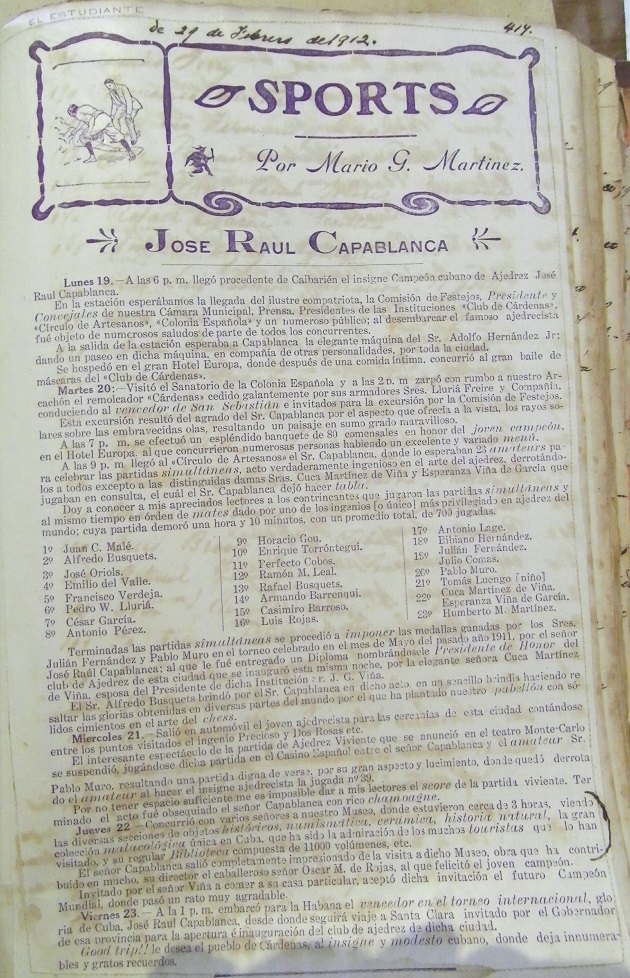
Yandy Rojas Barrios (Cárdenas, Cuba) forwards this page from the magazine El Estudiante (Cárdenas), 29 February 1912, which has details of Capablanca’s visit to the city on 19-23 February:
‘The item has been preserved in the Libro de Actas y Correspondencia del Museo y Biblioteca Pública de Cárdenas (today the Museo Oscar María de Rojas), and was sent to me by the Cardenense writer, historian and museologist Ernesto Aramis Álvarez Blanco, whose brother is the grandmaster Aramis Álvarez.’
11732. Arturo Pomar
Arturo Pomar is the subject of the latest book that we have acquired, El peón by Paco Cerdà (Logroño, 2020):
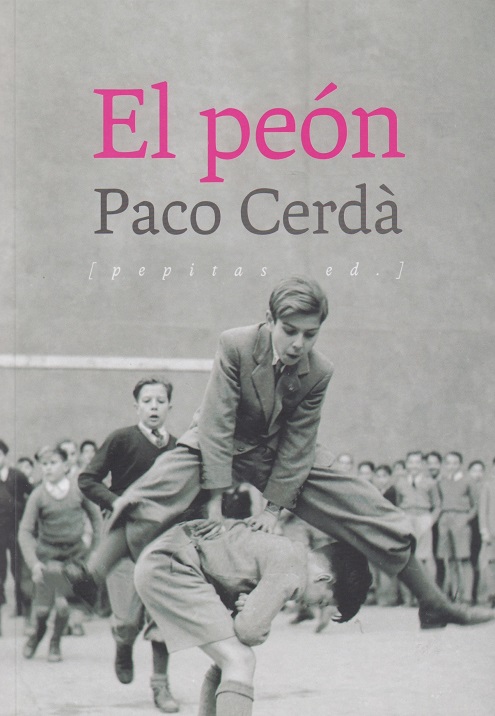
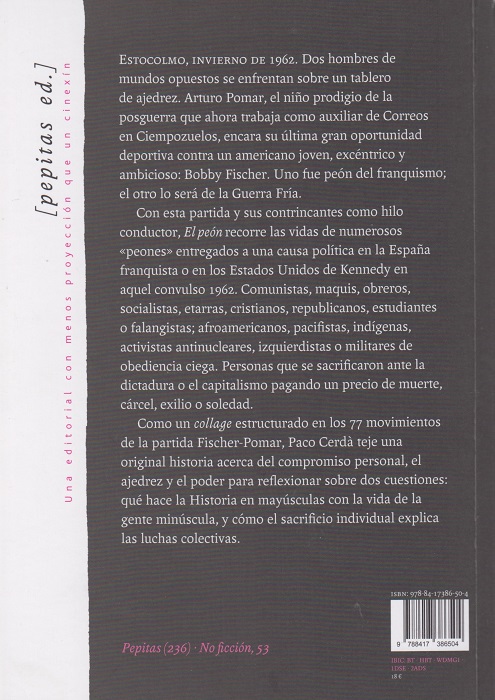
11733. An identification challenge
Concerning this photograph, provided by Olimpiu G. Urcan (Singapore), readers may be able to identify not only the players but, even, the book on the table (our copy of which is to hand):
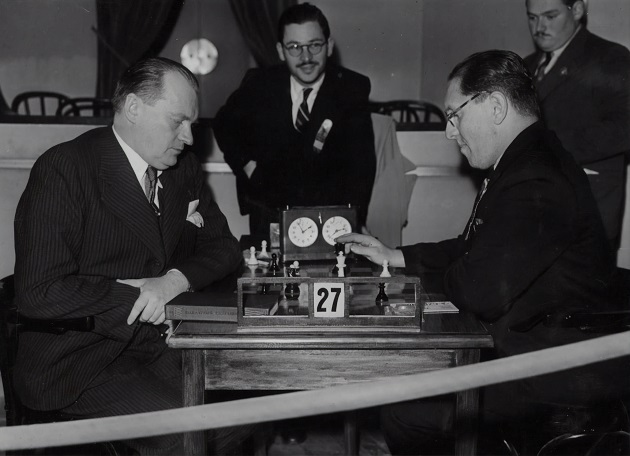
11734. Mozart
Russian-language additions to ‘The Mozart of Chess’ have come from Yuri Kireev and Mikhail Sokolov (Moscow), with regard to Capablanca, Fischer and Reshevsky.
A comparison between Capablanca and Mozart appeared in a biography of Prokofiev by Sergei Morozov (Leningrad, 1967). Page 60 stated, without a source, that at St Petersburg, 1914 the young Prokofiev, delighted with the play of Capablanca and Lasker, wrote an article for the newspaper Den which equated Capablanca with Mozart, and Lasker with Bach; however, for personal reasons Prokofiev did not send the note to the newspaper.
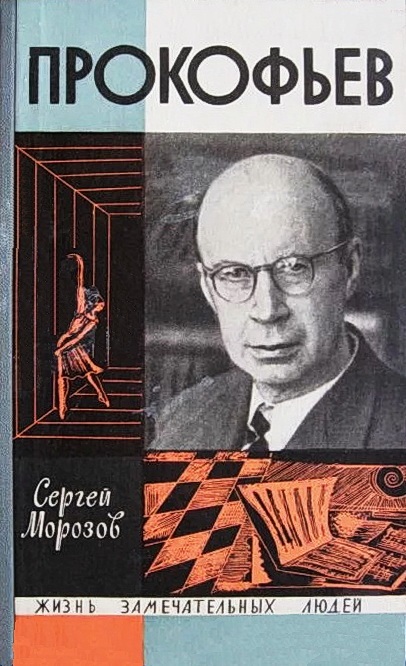
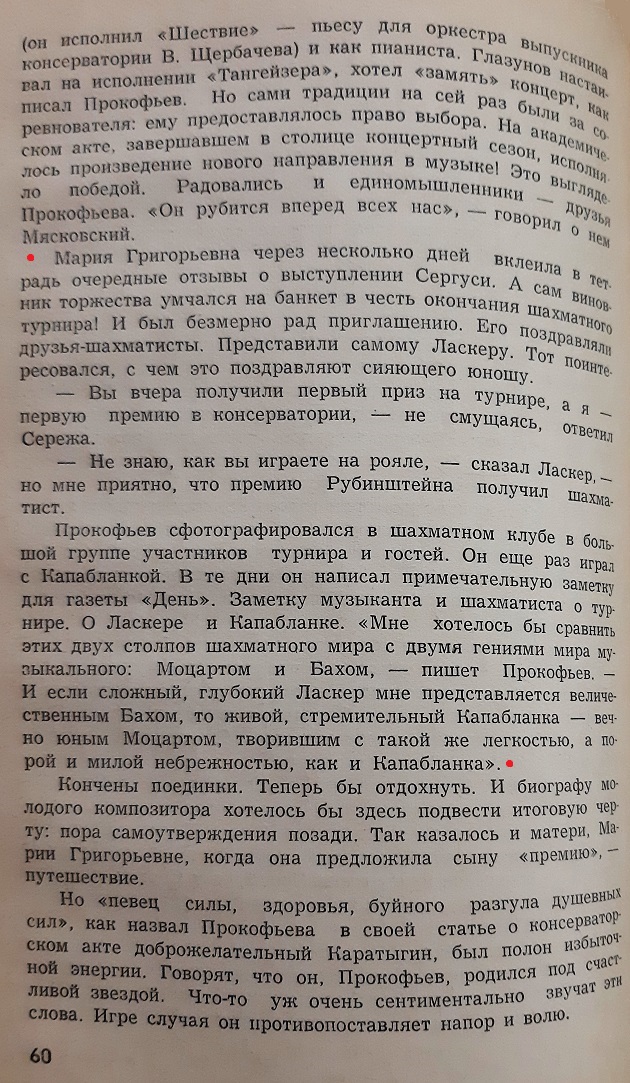
On page 4 of the 52/1974 issue of 64, in an article about Prokofiev and St Petersburg, 1914 by M. Petrova, Prokofiev’s note about Capablanca and Lasker was cited, with a source specified: the composer’s personal collection in the Central State Archive of Literature and Art of the USSR (TsGALI):
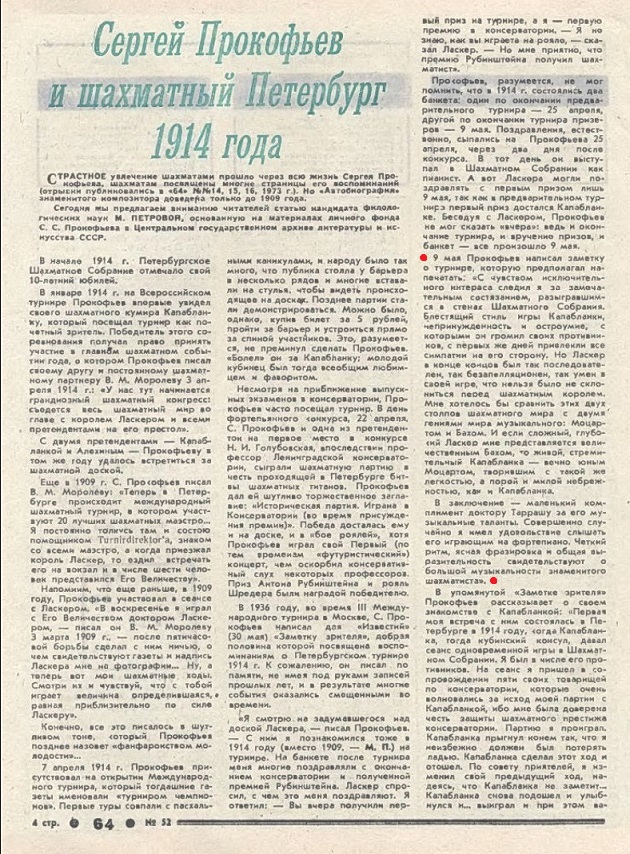
The same information as in 64 was on page 41 of Y. Sviatoslav’s monograph on Prokofiev and chess (Moscow, 2000):
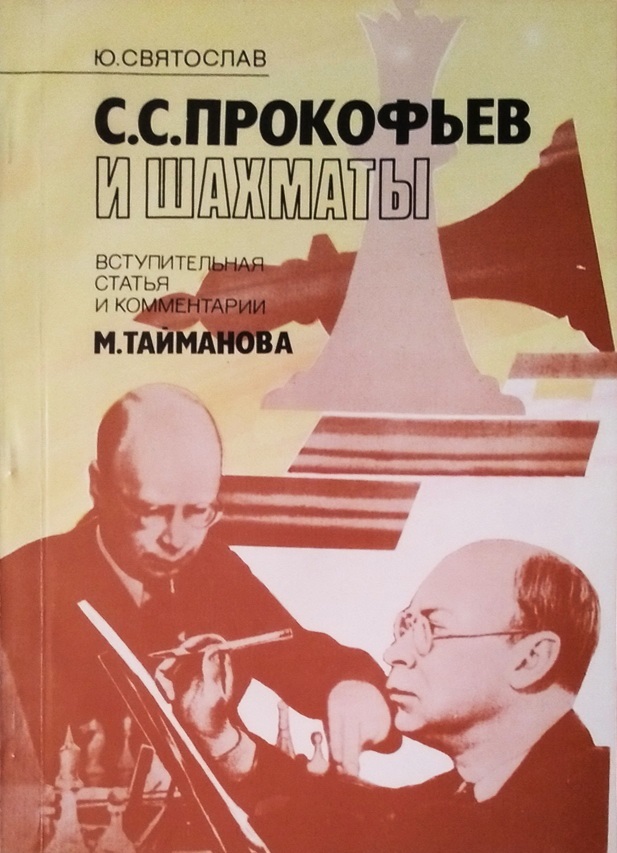
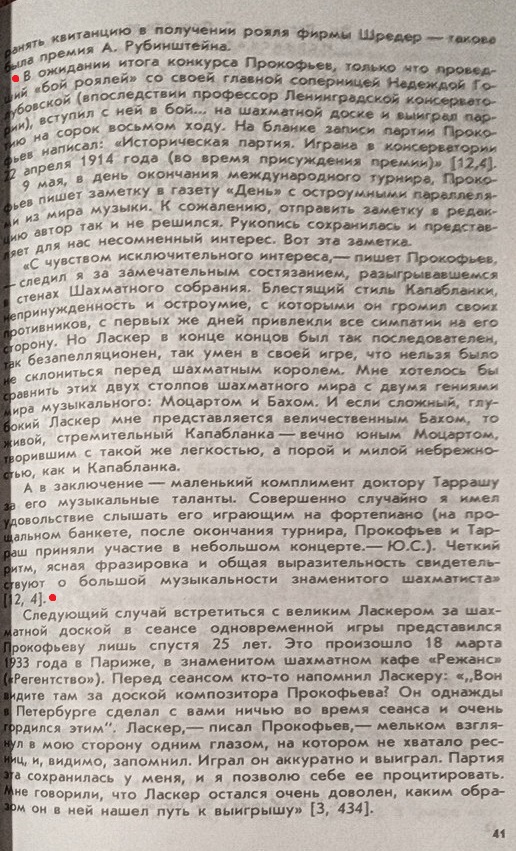
Our correspondents comment:
‘The question that arises is what date should be considered the first appearance of Prokofiev’s comparison of Capablanca with Mozart. From unsourced information in a book by Morozov (1967), from the 1974 article by Petrova, or from the note by Prokofiev in 1914 (the original of which we have not found)?’
Regarding Fischer, they point out that a slightly updated translation of H.C. Schonberg’s 1958 New York Times article ‘Fourteen-Year-Old “Mozart of Chess”’ (C.N. 5491) ...

... was published on page 52 of the 22/1958 issue of America (with the author’s name given as ‘Nonberg’), accompanied by a photograph of Fischer in play against Rodolfo Cardoso:
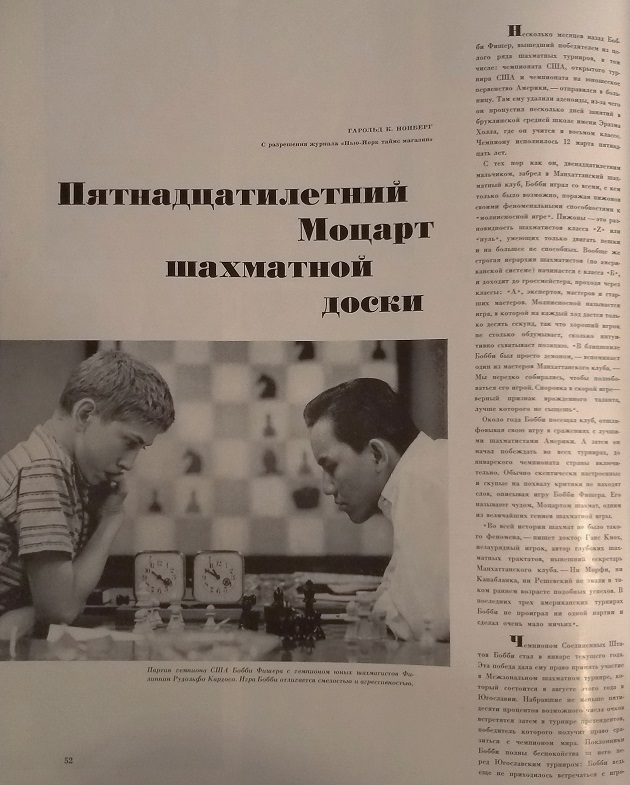
Finally, Mr Kireev and Mr Sokolov note that Reshevsky was called the Mozart of chess on the cover of the 2/2005 issue of Sportivnaya zhizn v Rossia in connection with an article on page 46 by E.Y. Gik, ‘Chess Wunderkind’ (which did not itself mention Mozart):

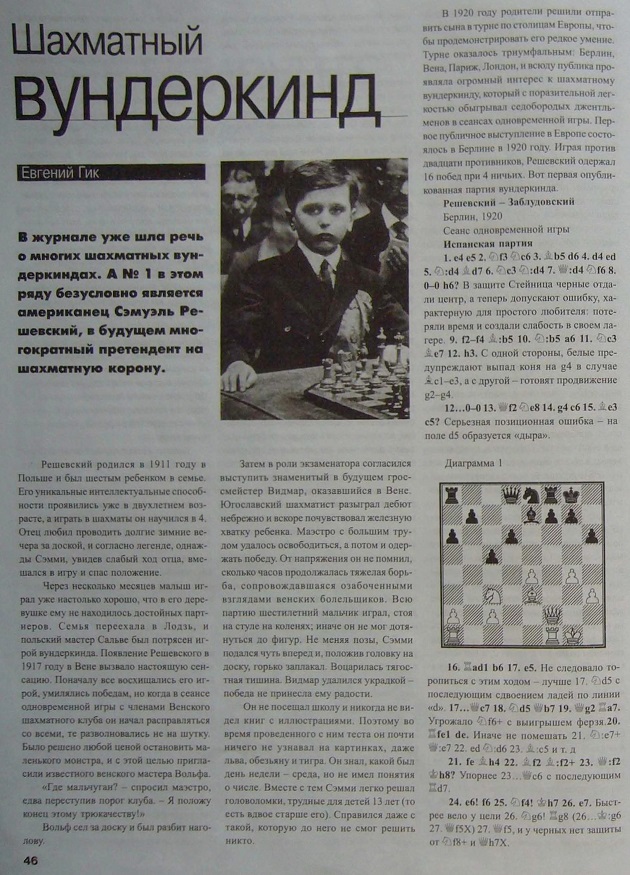
11735. A Big Churchman’s
A further instance of Chess in Advertisements, from page 11 of the Daily Mail, 11 July 1931:
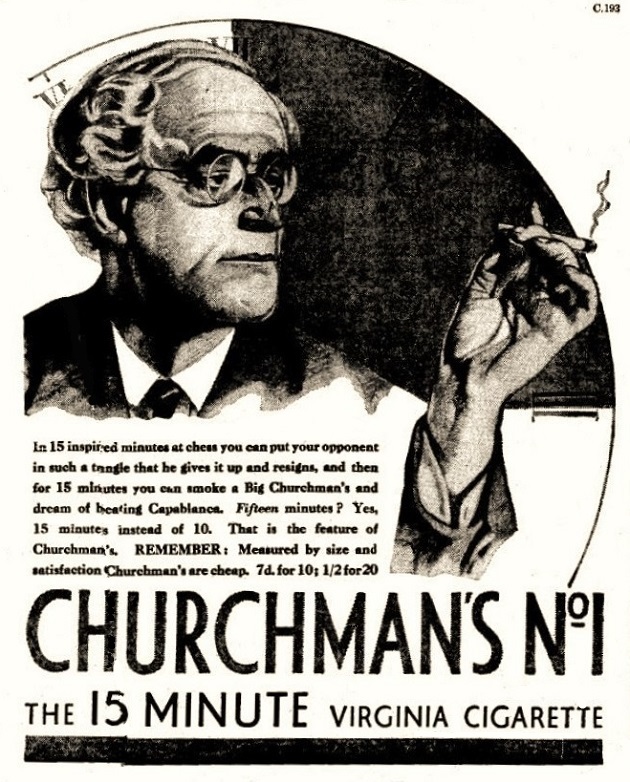
11736. Arthur Ford Mackenzie
Michael McDowell (Westcliff-on-sea, England) draws attention to this excerpt from a chess column by Robert J. Buckley in the Birmingham Weekly Mercury, 6 February 1897, as included in a set of scrapbooks held by the Cleveland Public Library:
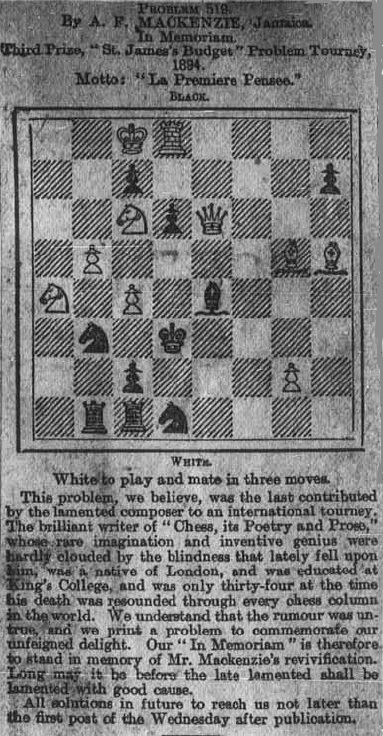
Mr McDowell comments:
‘Buckley’s piece is strange in that it gives details of Mackenzie’s birth and education which contradict A.C. White in his collection Chess Lyrics.’
He also notes that the Cleveland Public Library Digital Gallery has these photographs (reproduced here with permission):
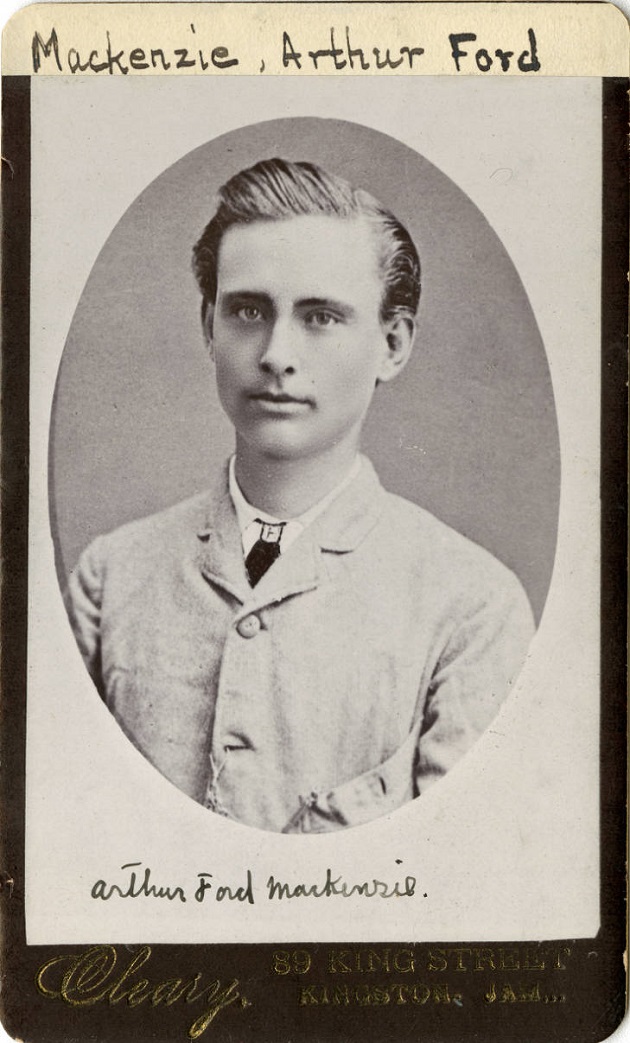

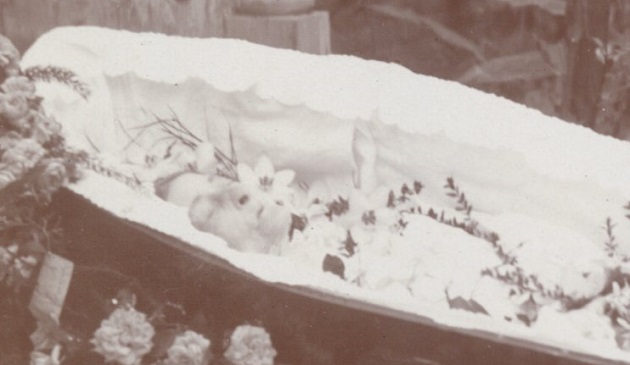
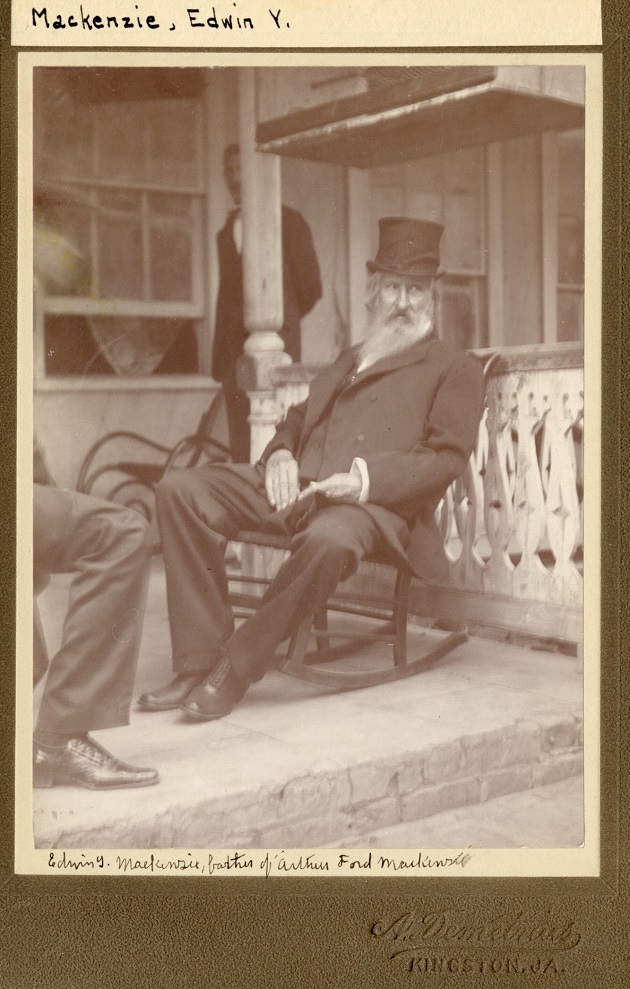
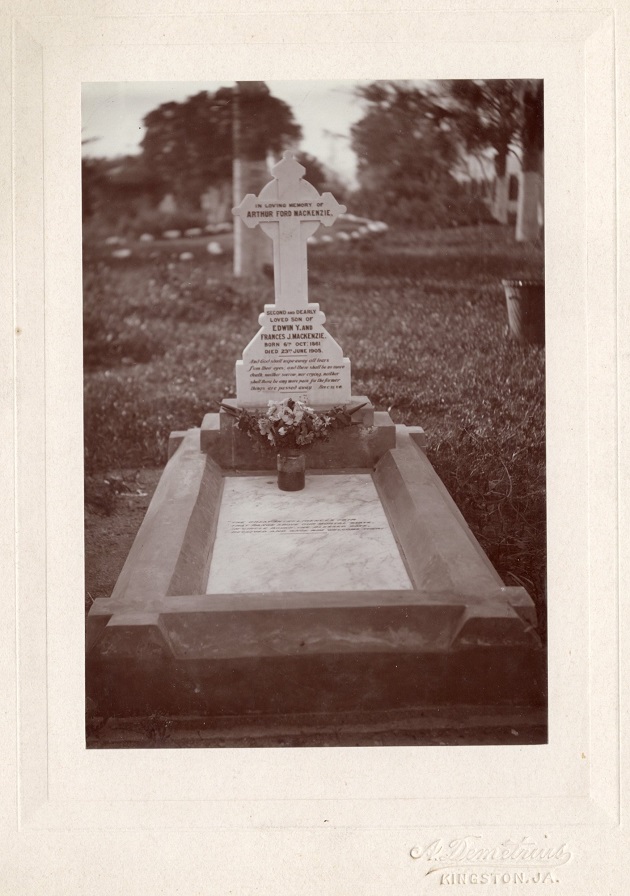

The first of the pictures, the fine portrait of A.F. Mackenzie, is in Chess and Untimely Death Notices, from page 278 of the August 1905 American Chess Bulletin. See too C.N.s 5289 and 5290.
Concerning Mackenzie’s loss of sight, below is a paragraph from the Problem Department of the Chess Player’s Chronicle, 24 April 1895, page 78:
‘We share the regret that is generally expressed on hearing that Mr A.F. Mackenzie, the expert in problem and general chess matters, has been suffering from an affection of the eyes, which has kept him from his favourite pursuits. We join in the wish that he may be speedily restored to health.’
A letter from Mackenzie was published on page 135 of the March 1896 BCM, in the ‘Problem World’ column conducted by James Rayner:
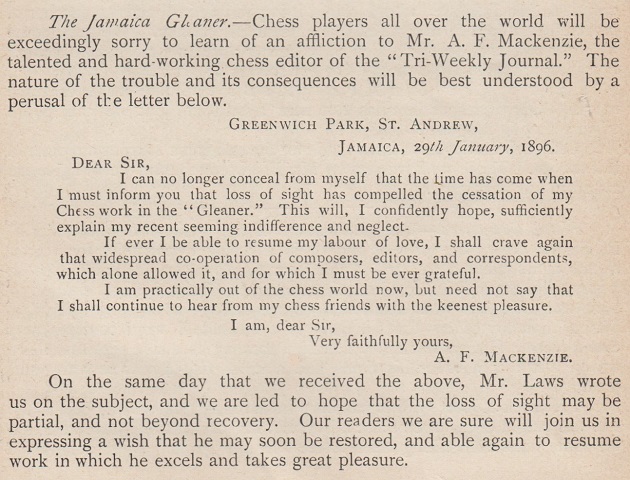
Rayner and Mackenzie died in, respectively, 1898 (aged 38) and 1905 (aged 43).
We conclude with John Keeble’s column in the Norwich Mercury, 19 July 1905, page 7:

11737. Bibliographies
How should bibliographies handle reprints? If, for instance, an author possesses only the Dover reprint (1960) of Réti’s Modern Ideas in Chess, can it be satisfactory to mention that edition alone, without even a reference to the date (1923) of the original Bell volume (reissued by the company in 1943)?
Part of the bibliography on pages 349-354 of The Personality of Chess by I.A. Horowitz and P.L. Rothenberg (New York, 1963):
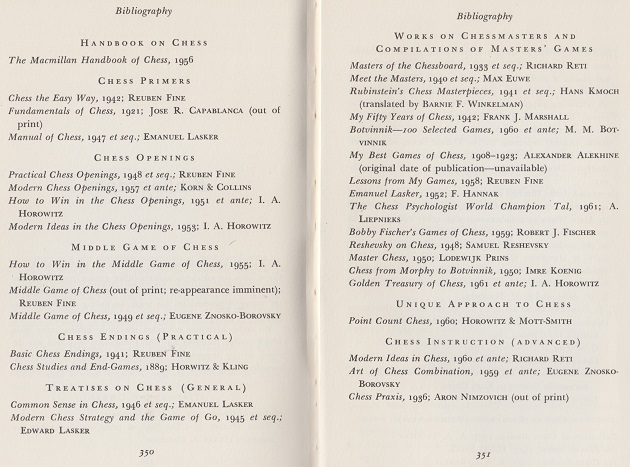
There are some obvious errors (e.g. ‘Fundamentals of Chess’ and ‘F. Hannak’) and a curious inability to say when Alekhine’s first Best Games volume was published (1927). One unusual feature, an attempt to address the reprint problem, is the use of ‘et ante’ and ‘et seq.’, although it causes more confusion. For example, ‘et ante’ is used for Modern Ideas in Chess but ‘et seq.’ for Emanuel Lasker’s books. See too the treatment of two works by Znosko-Borovsky.
11738. Chester Fox
Douglas Stidham (Austin, TX, USA) asks how much of the 1972 Spassky v Fischer match was filmed by Chester Fox, and where the footage is today. Such questions are often asked, but we have found no definitive answer. Can readers assist?
From page A-6 of the Record (Bergen County, NJ, USA), 18 August 1972:
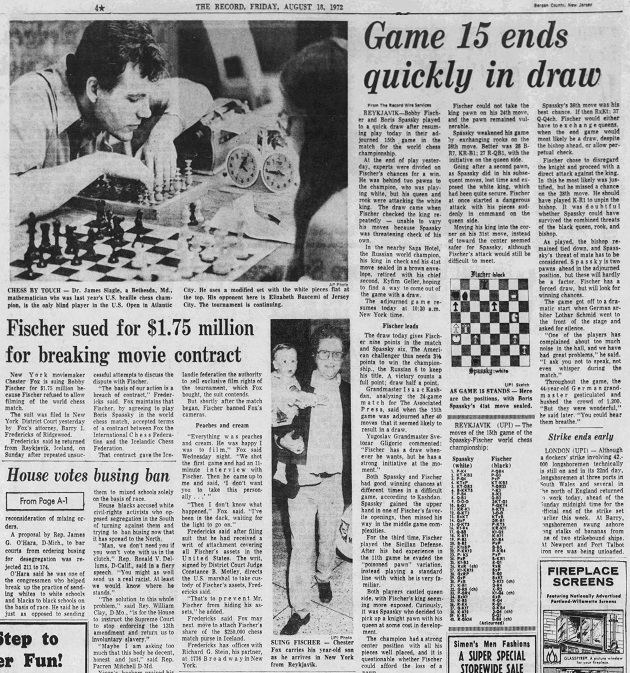
Lesser-known information about Chester Fox in Reykjavik is available at the Icelandic website Tímarit.is.
11739. Simultaneous blindfold match
From page 150 of the Chess Player’s Chronicle, 12 June 1895:

The match between Curnock and Lawrence, duly played on 15 June 1895, was discussed on pages 161-162 of the 19 June 1895 issue, with all six game-scores given on pages 167-169 from Gunsberg’s Daily News column. Lawrence won games two and six, each in 15 moves but the latter after adjudication. Game one was left unfinished after 17 moves, and games three, four and five were also adjudicated as drawn, each after 15 moves. Lawrence’s win in game two:
1 e4 e5 2 f4 Bc5 3 Nc3 d6 4 Nf3 Nf6 5 d3 Ng4 6 d4 exd4 7 h3 dxc3 8 hxg4 Bxg4 9 Bc4 c6 10 Qd3 Bxf3 11 Qxf3 Qb6 12 b3 Nd7
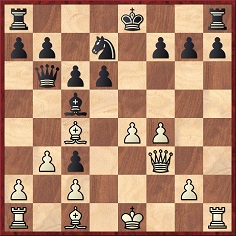
13 Ke2 O-O-O 14 Be3 d5 15 exd5 Rhe8 16 White resigns.
11740. An identification challenge (C.N. 11733)

This photograph (reference AR_AGN_DDF/Consulta_INV: 135060) comes from Argentina’s Archivo General de la Nación, courtesy of the Ministerio del Interior, Obras Públicas y Vivienda. The reverse:
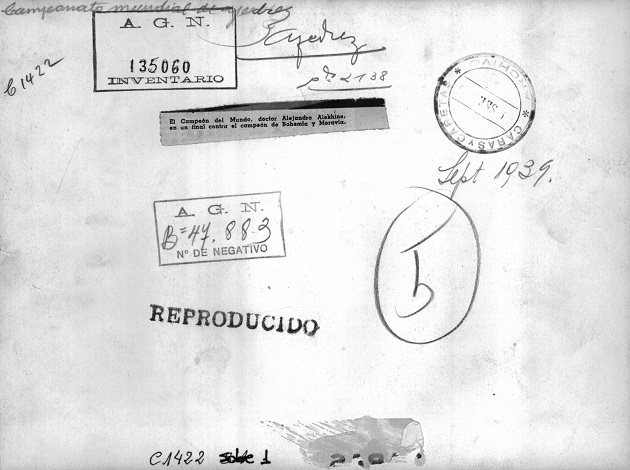
The statement that Alekhine’s opponent was ‘el campeón de Bohemia y Moravia’ (Karel Opočenský) is incorrect. It was Moshe Czerniak, and the first two letters of his surname are visible in front of him.
The book at Alekhine’s side is the second volume of Шахматный ежегодник by N. Grekov and I. Maizelis:

Our copy:

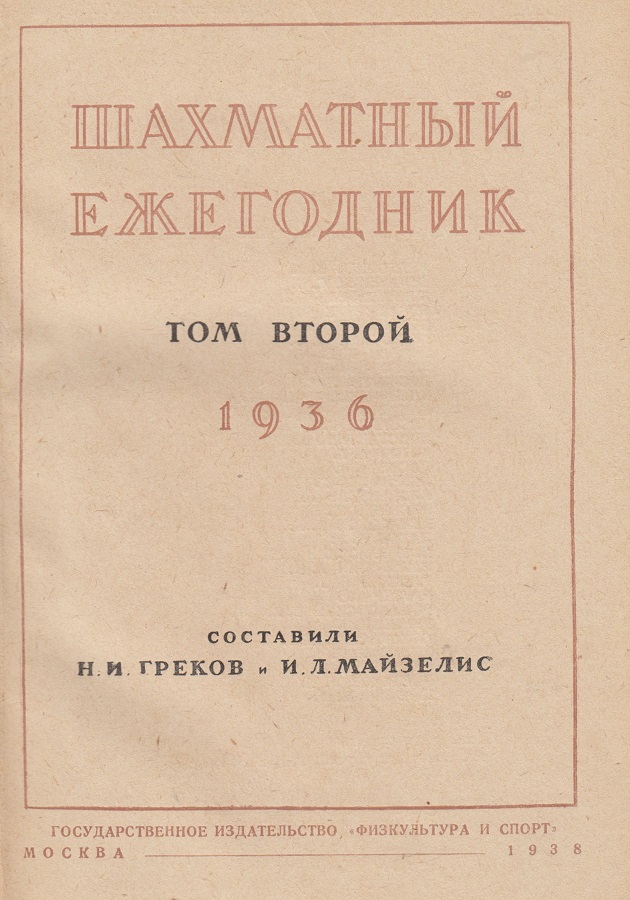
11741. A further Alekhine photograph
Olimpiu G. Urcan (Singapore) provides another photograph (reference AR_AGN_DDF/Consulta_INV: 135394) from the Argentinian archive mentioned in the previous item:
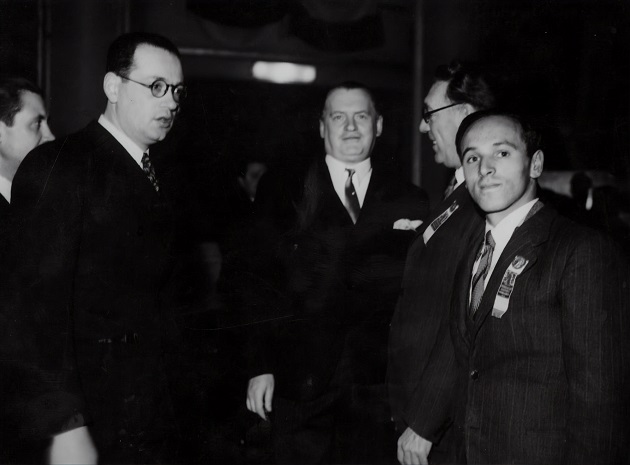
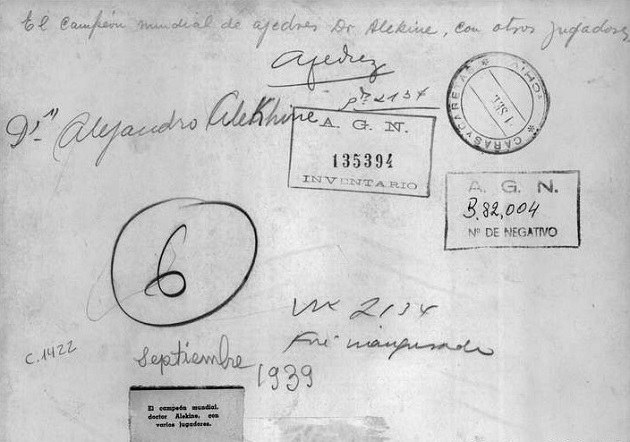
11742. Buenos Aires, 1939
Eduardo Bauzá Mercére (New York, NY, USA) sends this page of photographs from section three of La Nación, 3 September 1939:
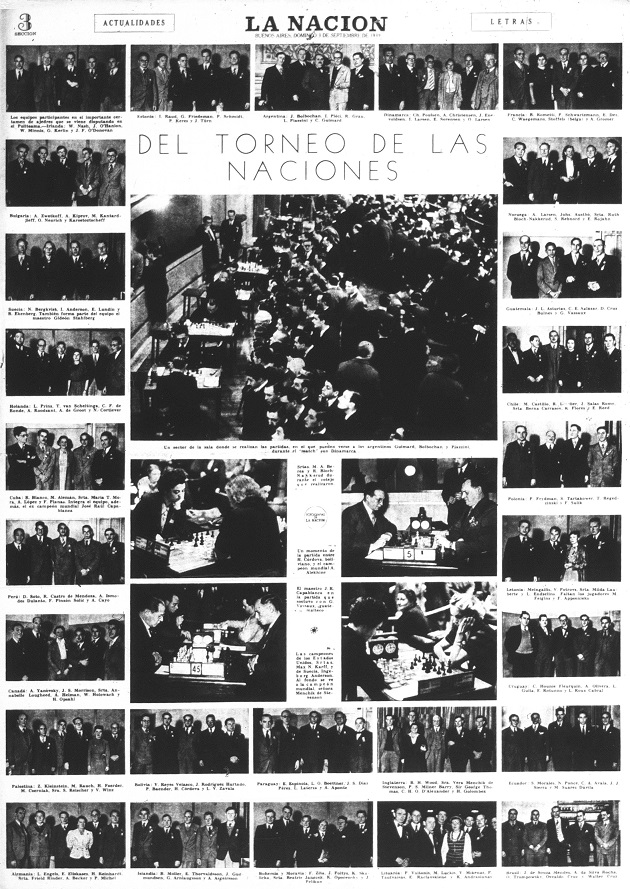
11743. Steinitz in New Orleans
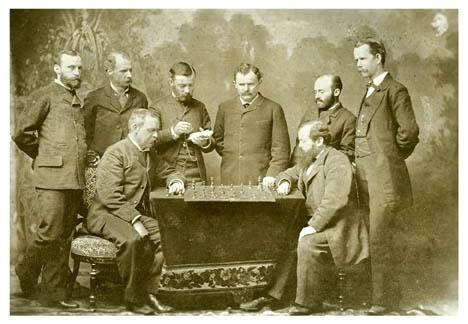
This photograph was discussed in C.N.s 3463, 5173 and 7611, with identification of the photographer in C.N. 5173: Theodore Lilienthal of New Orleans.
From the same period (January 1883) the Cleveland Public Library has a portrait of Steinitz, reproduced below with permission, which also mentions Lilienthal:
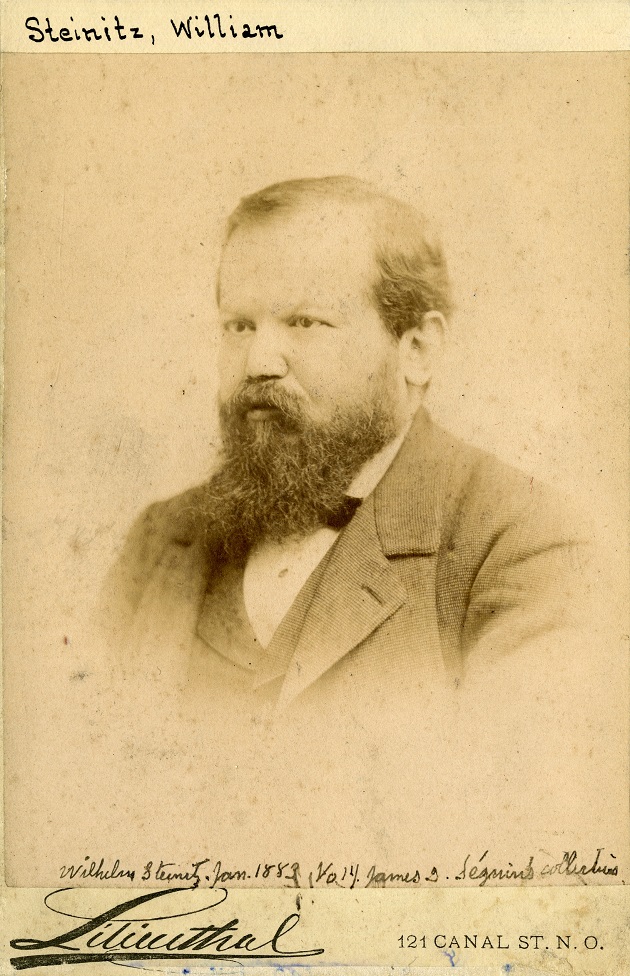
11744. Arthur Ford Mackenzie (C.N. 11736)
Information about A.F. Mackenzie’s origins is supplied by Michael McDowell (Westcliff-on-sea, England), from page xi of the collection of Mackenzie’s problems, Chess Lyrics edited by Alain C. White (New York, 1905):
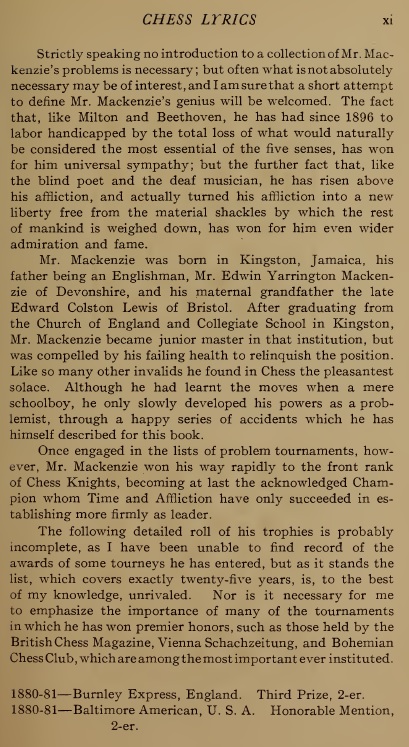
| First column | << previous | Archives [187] | next >> | Current column |
Copyright: Edward Winter. All rights reserved.